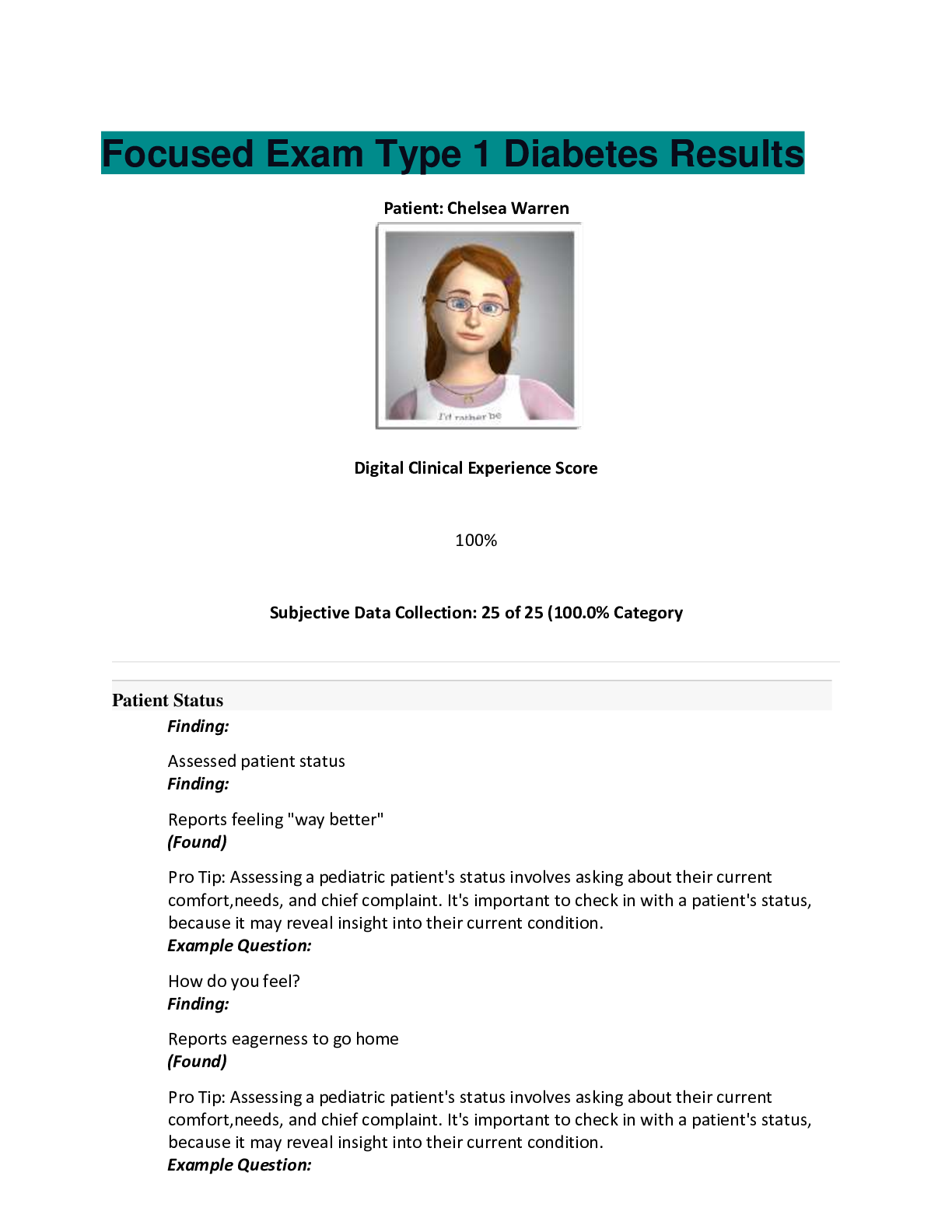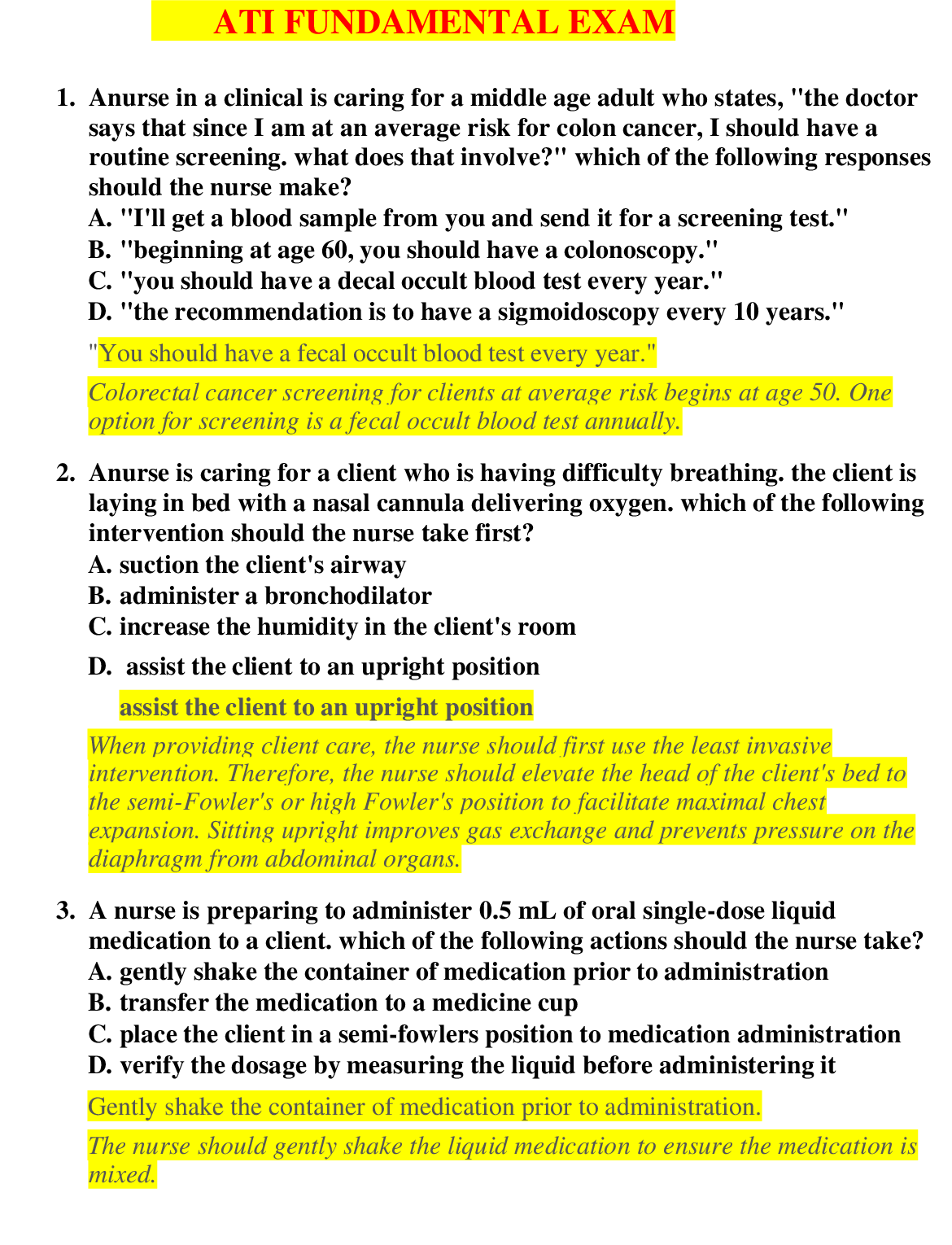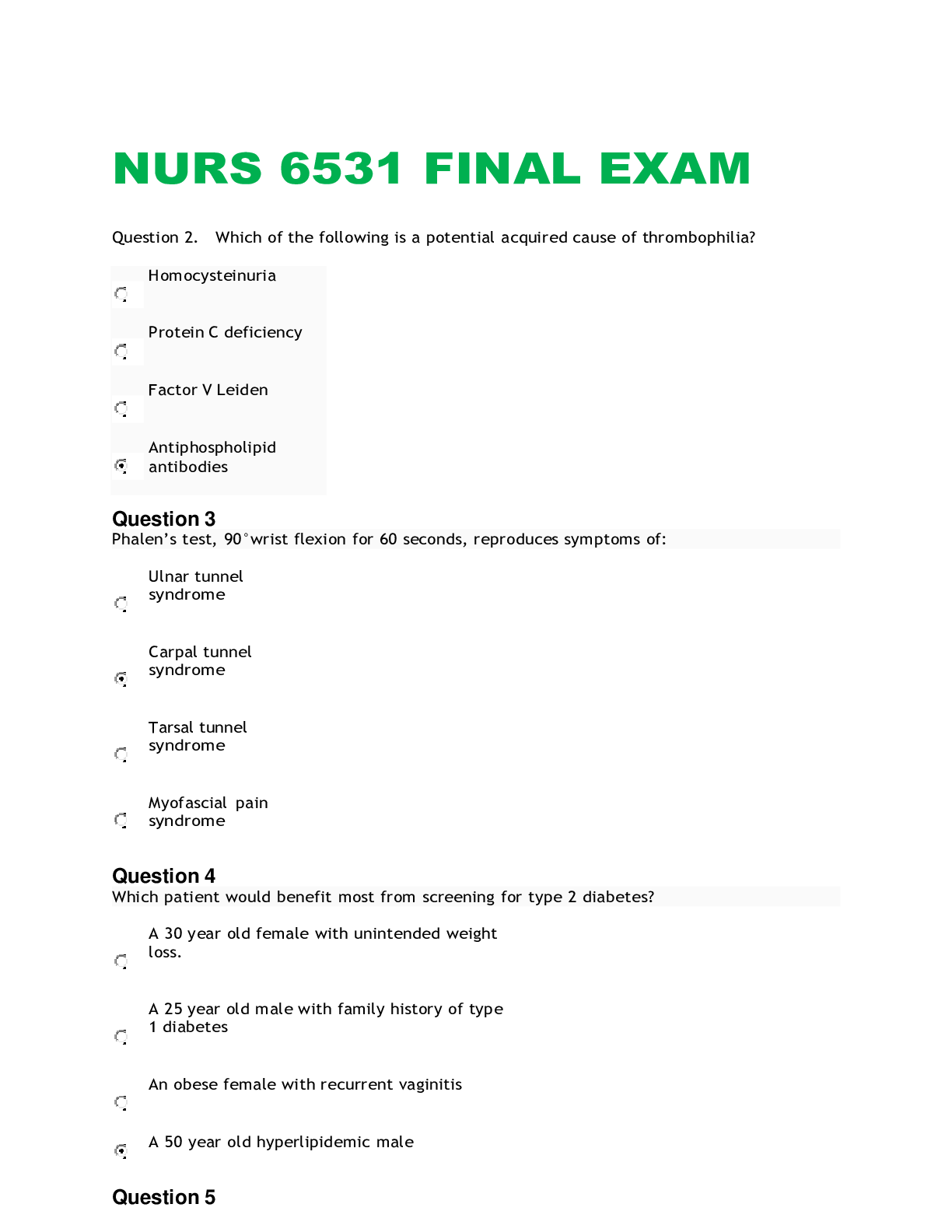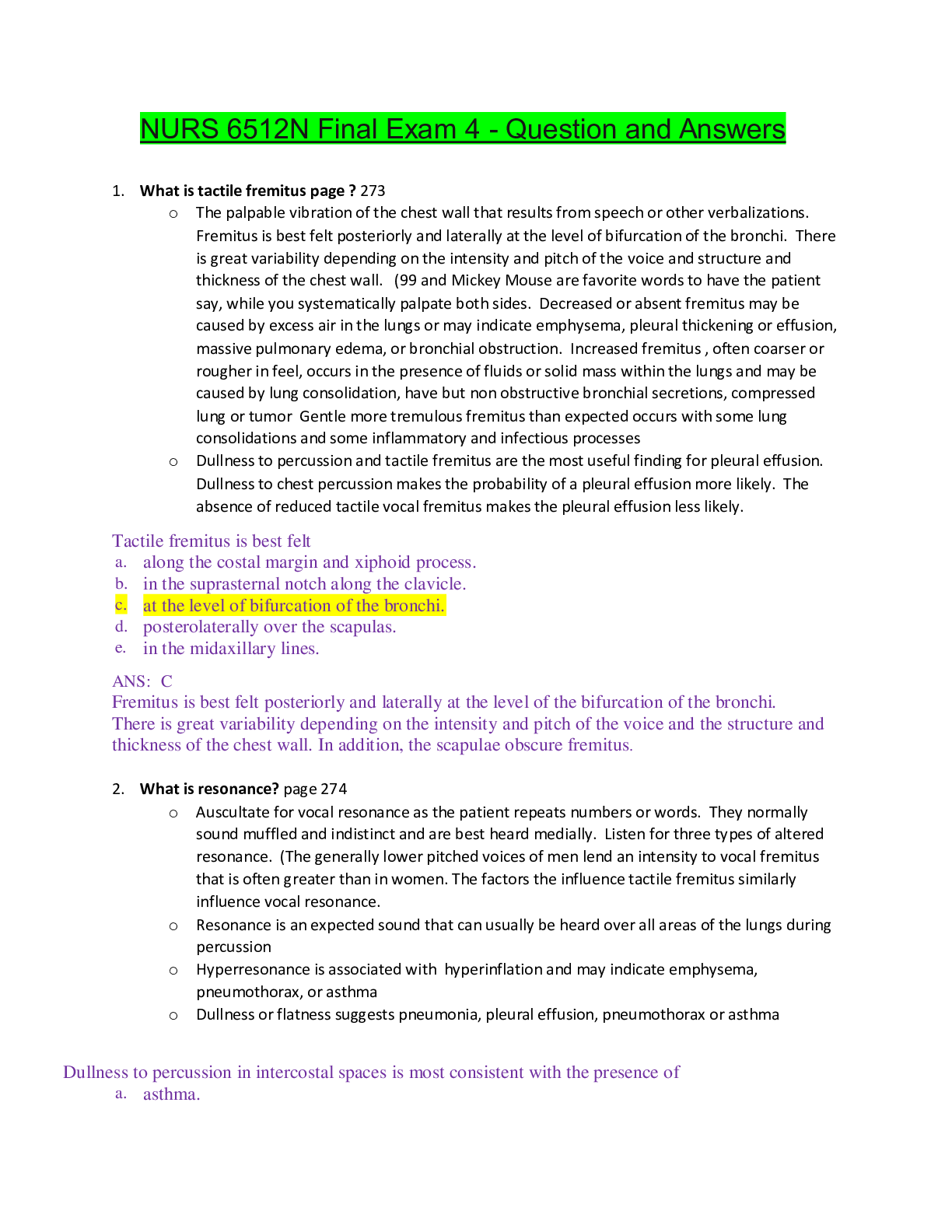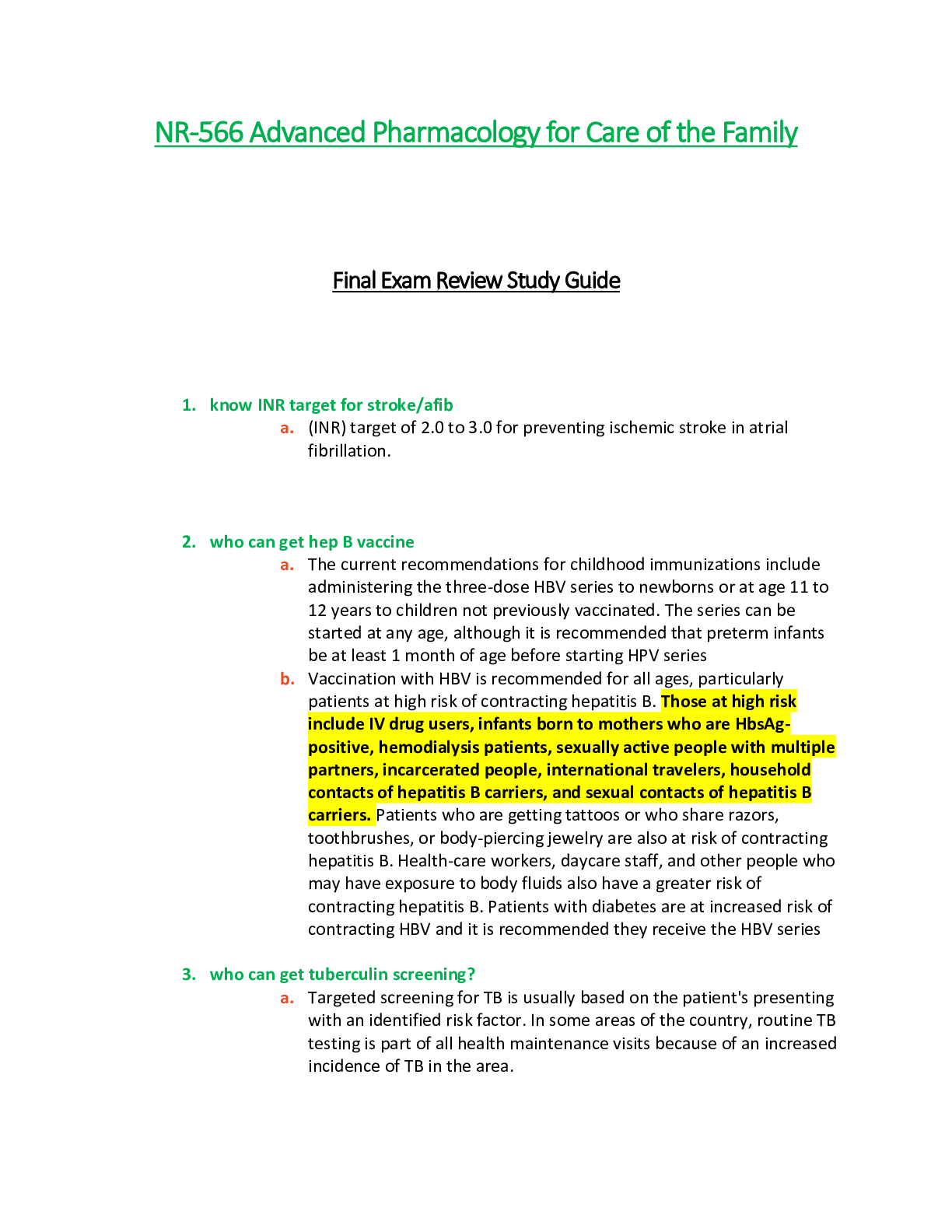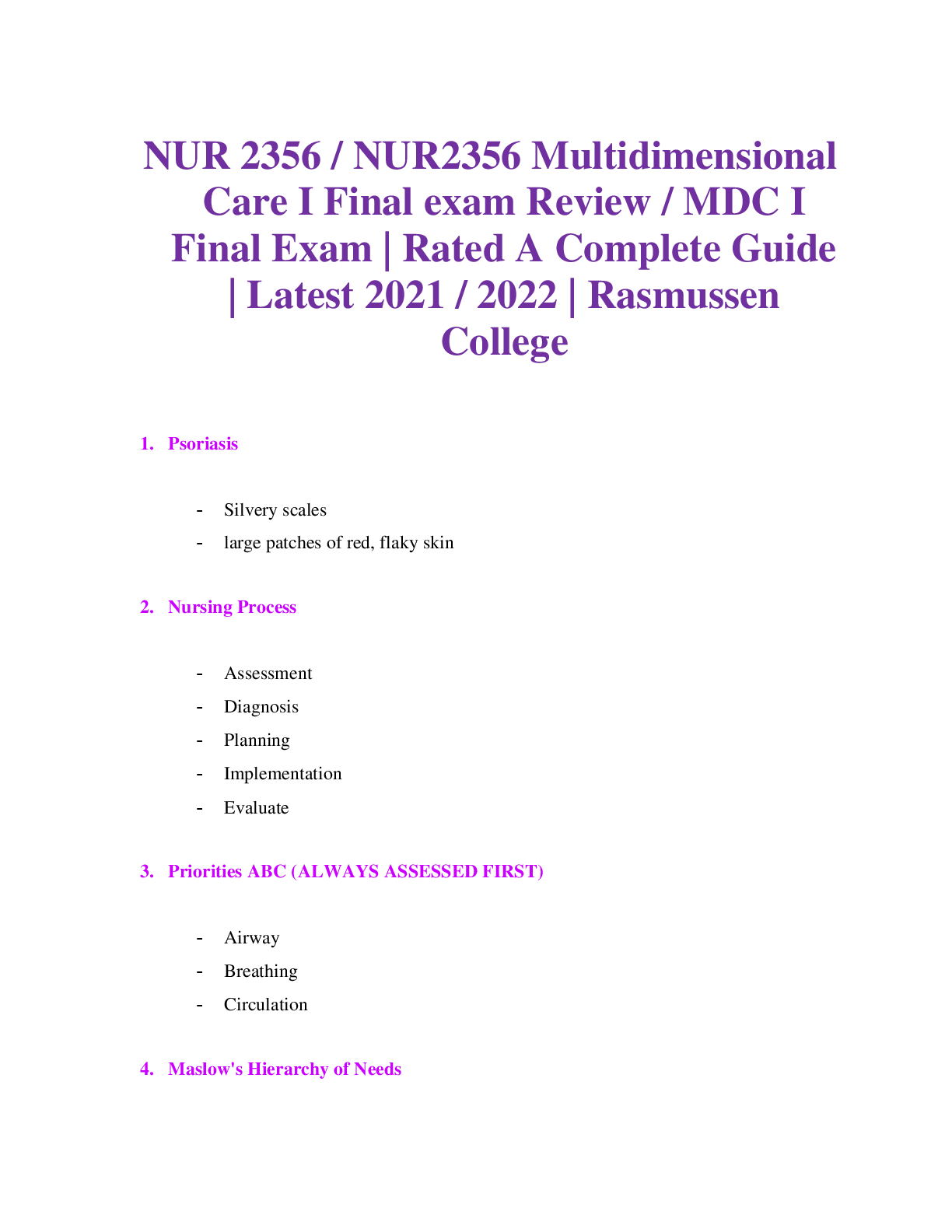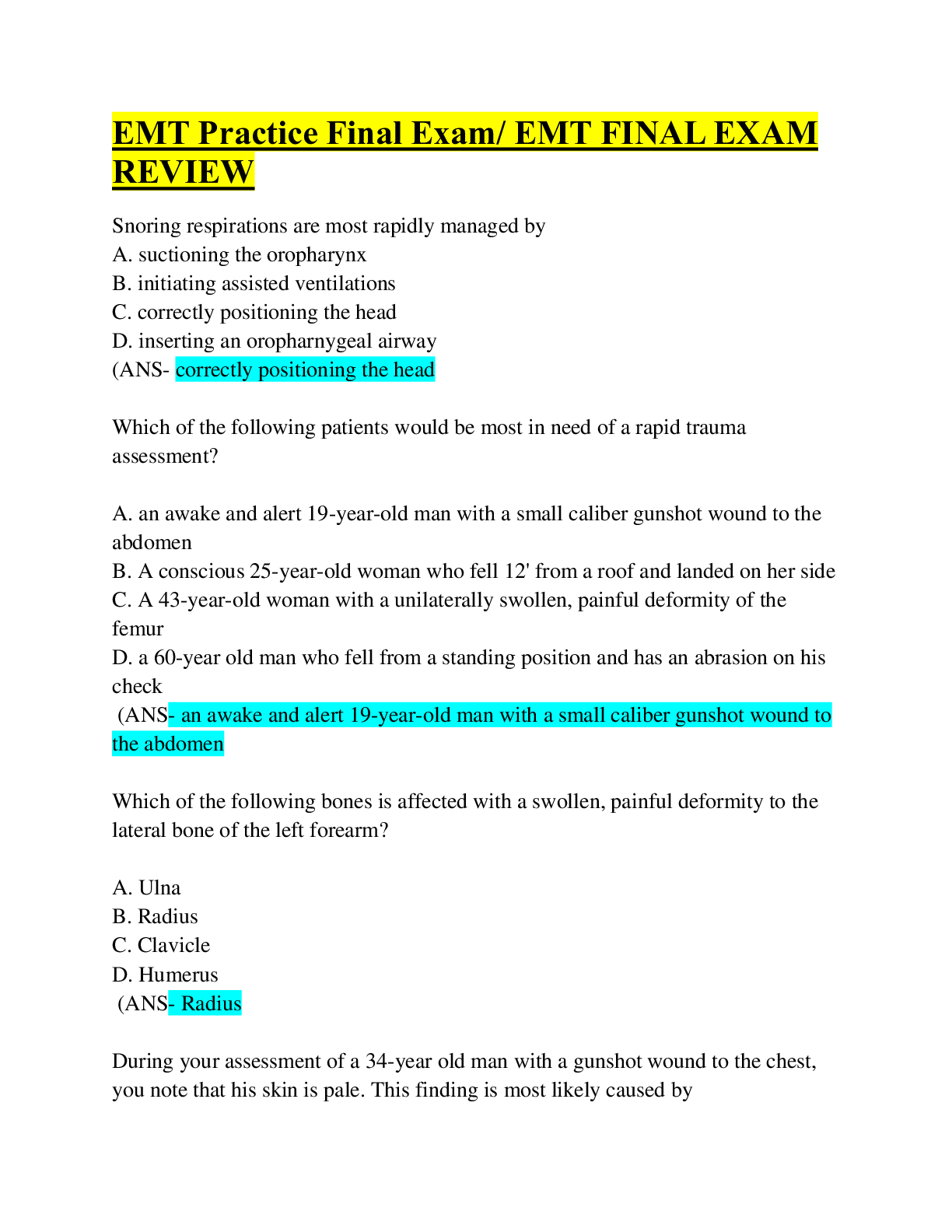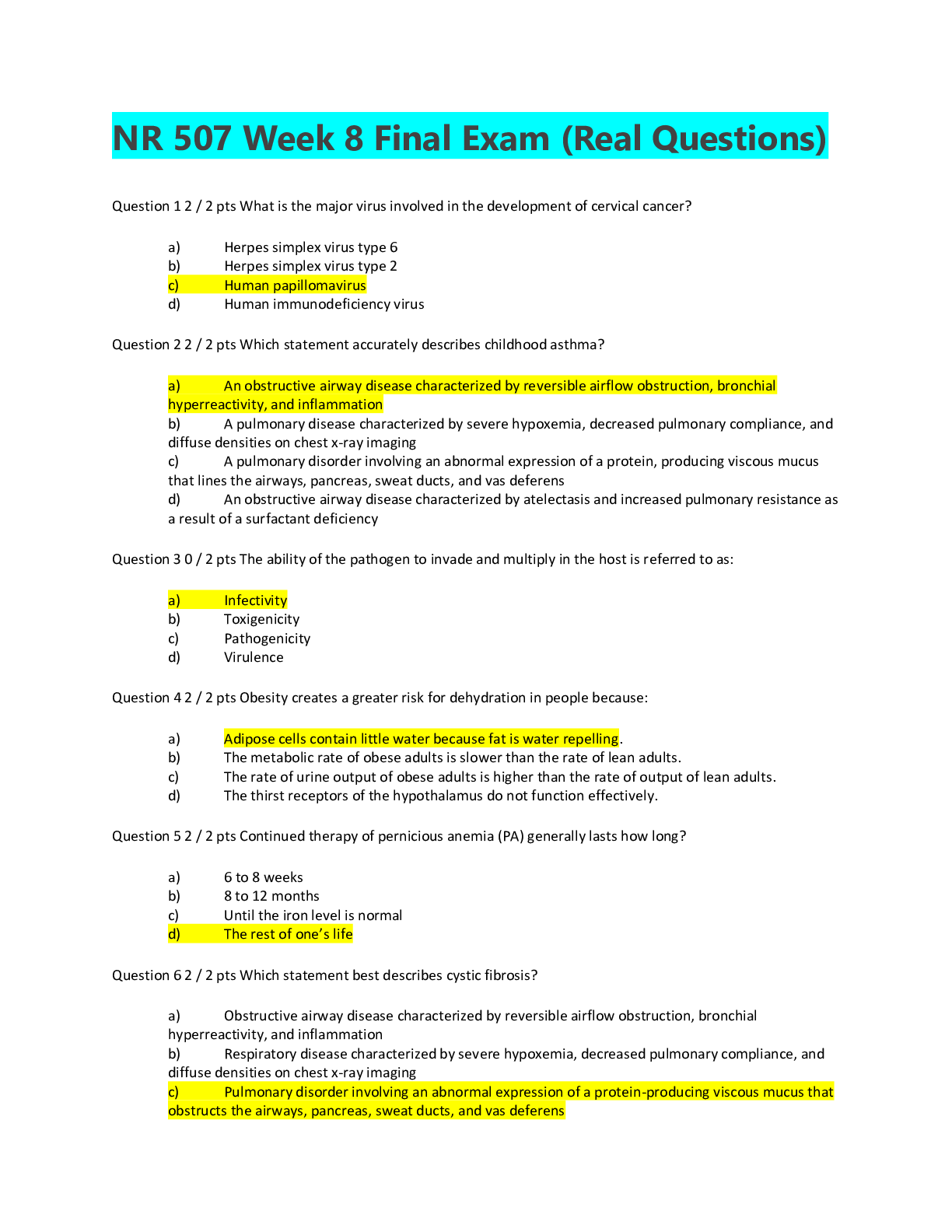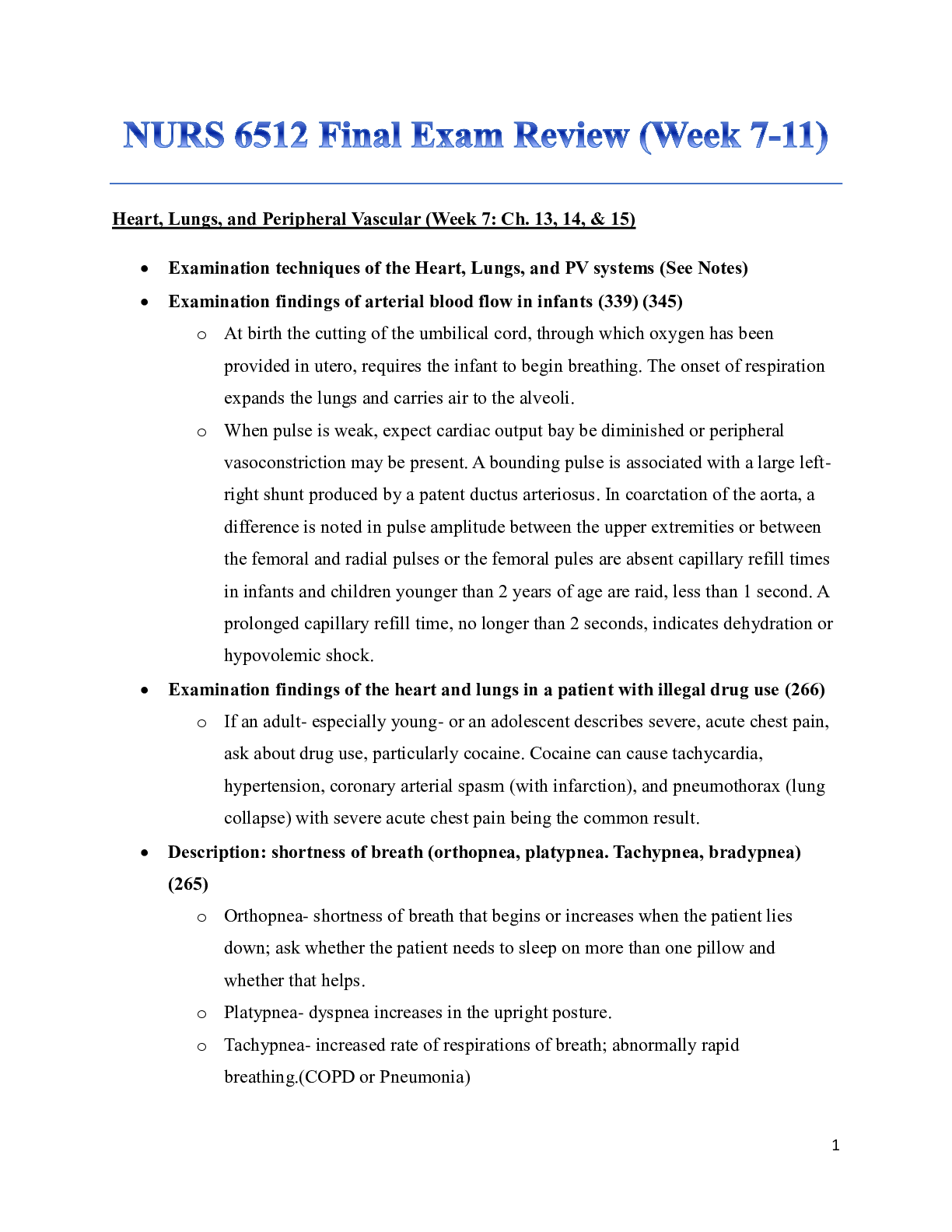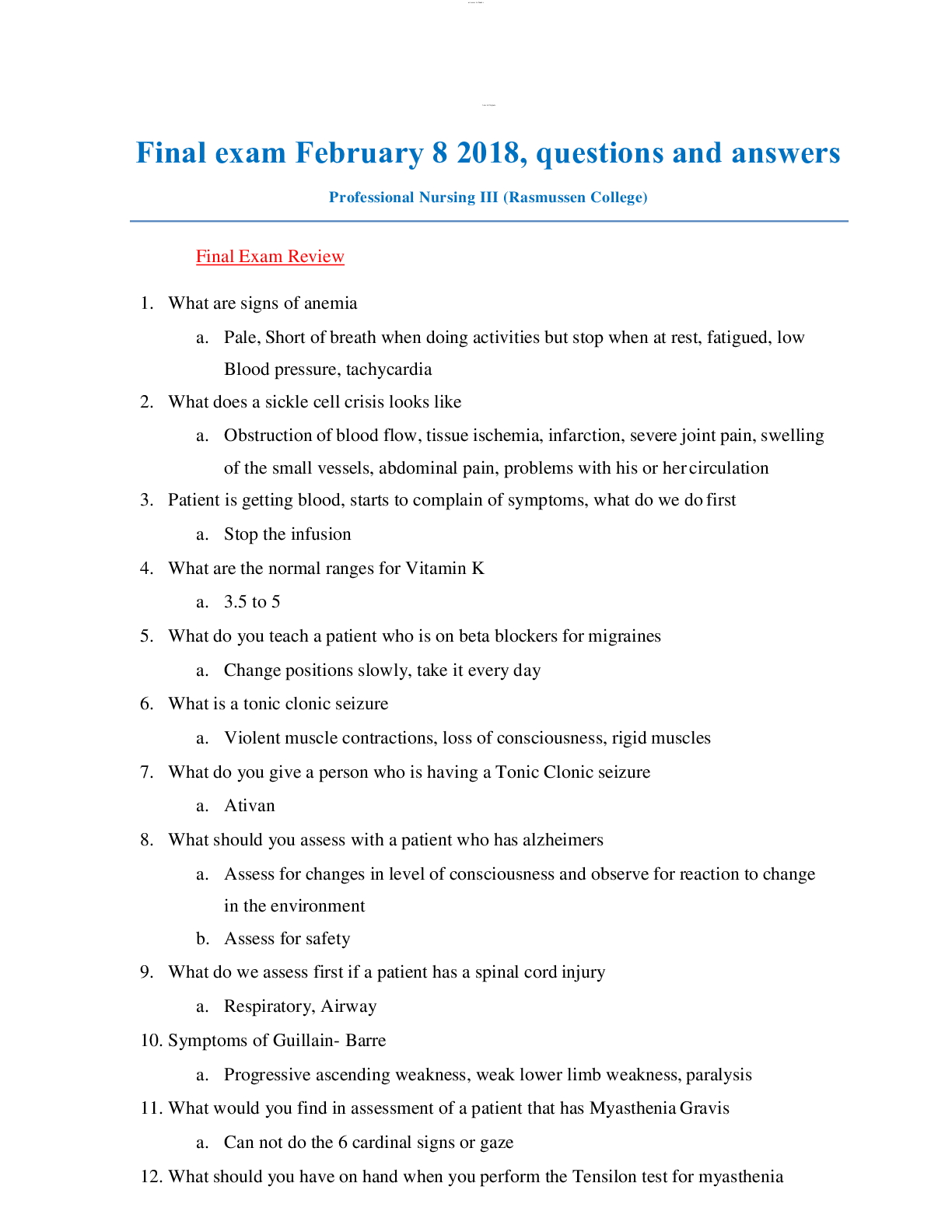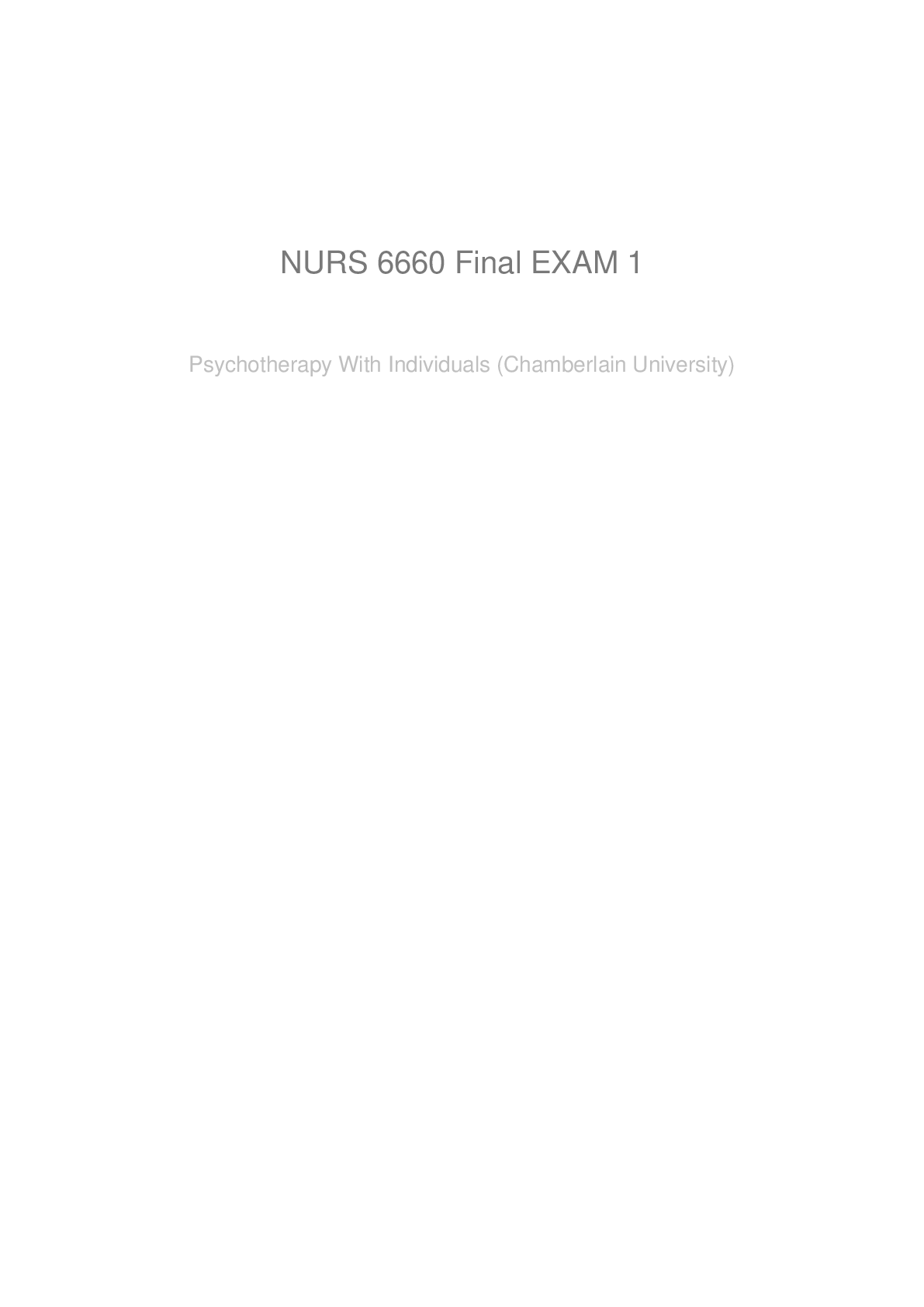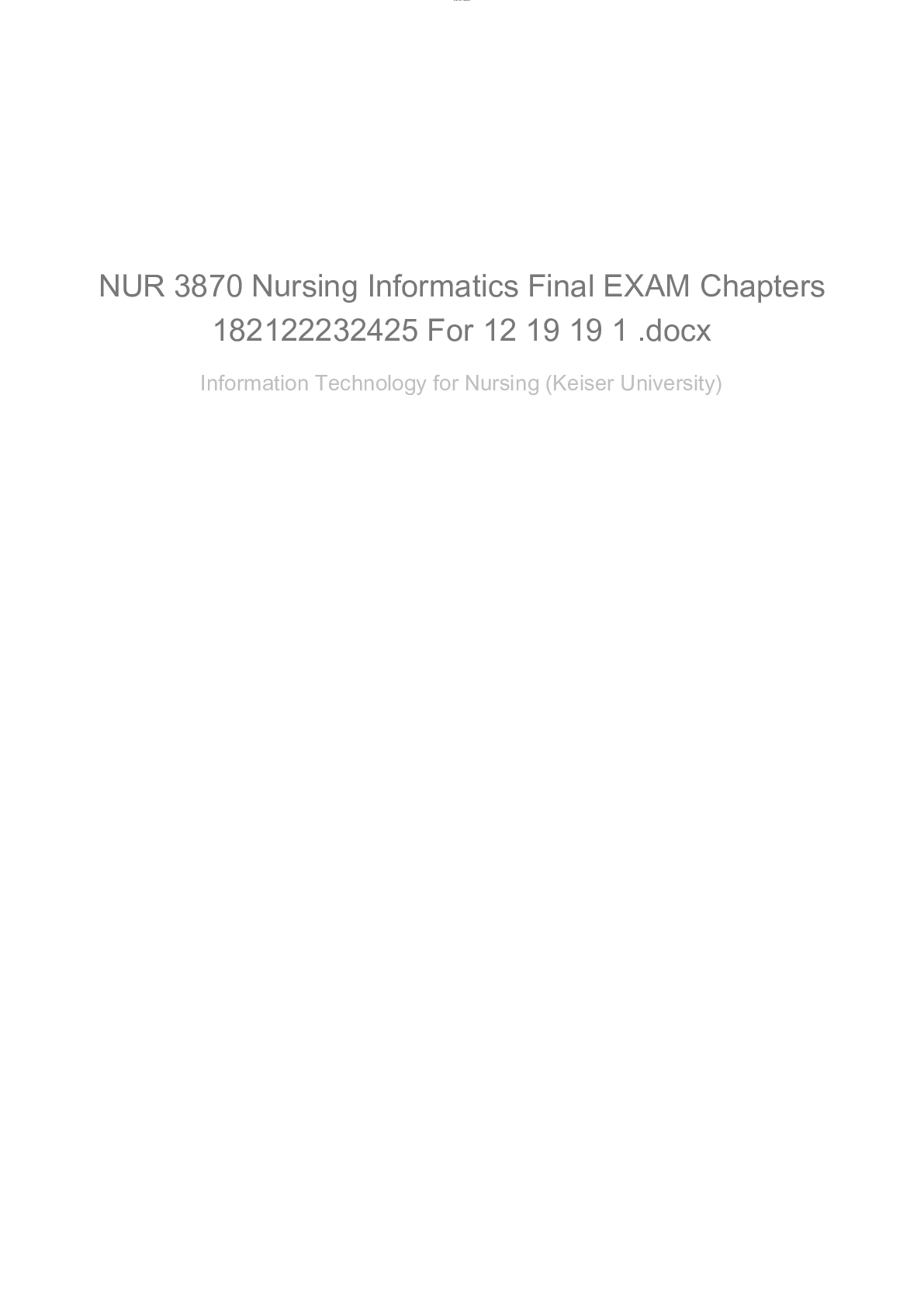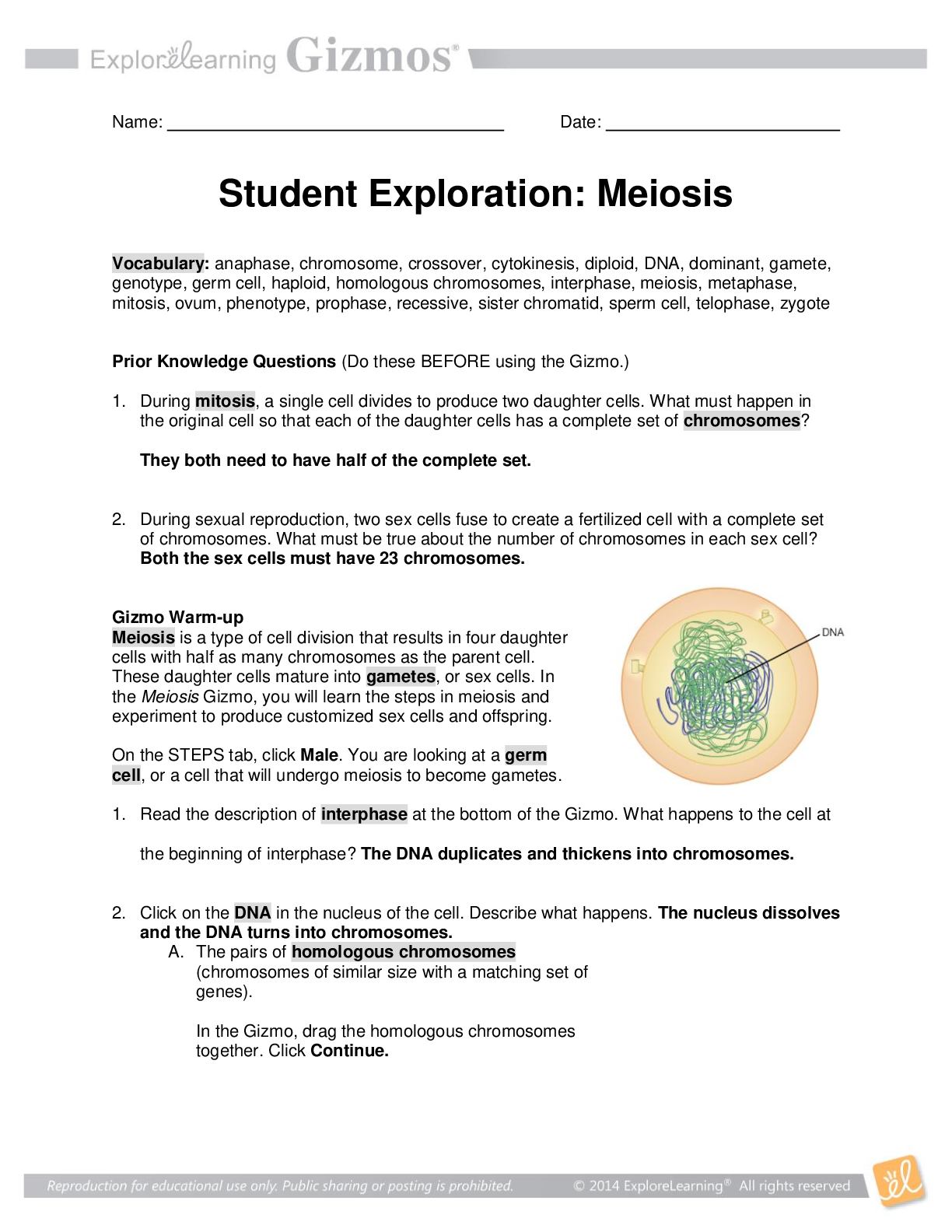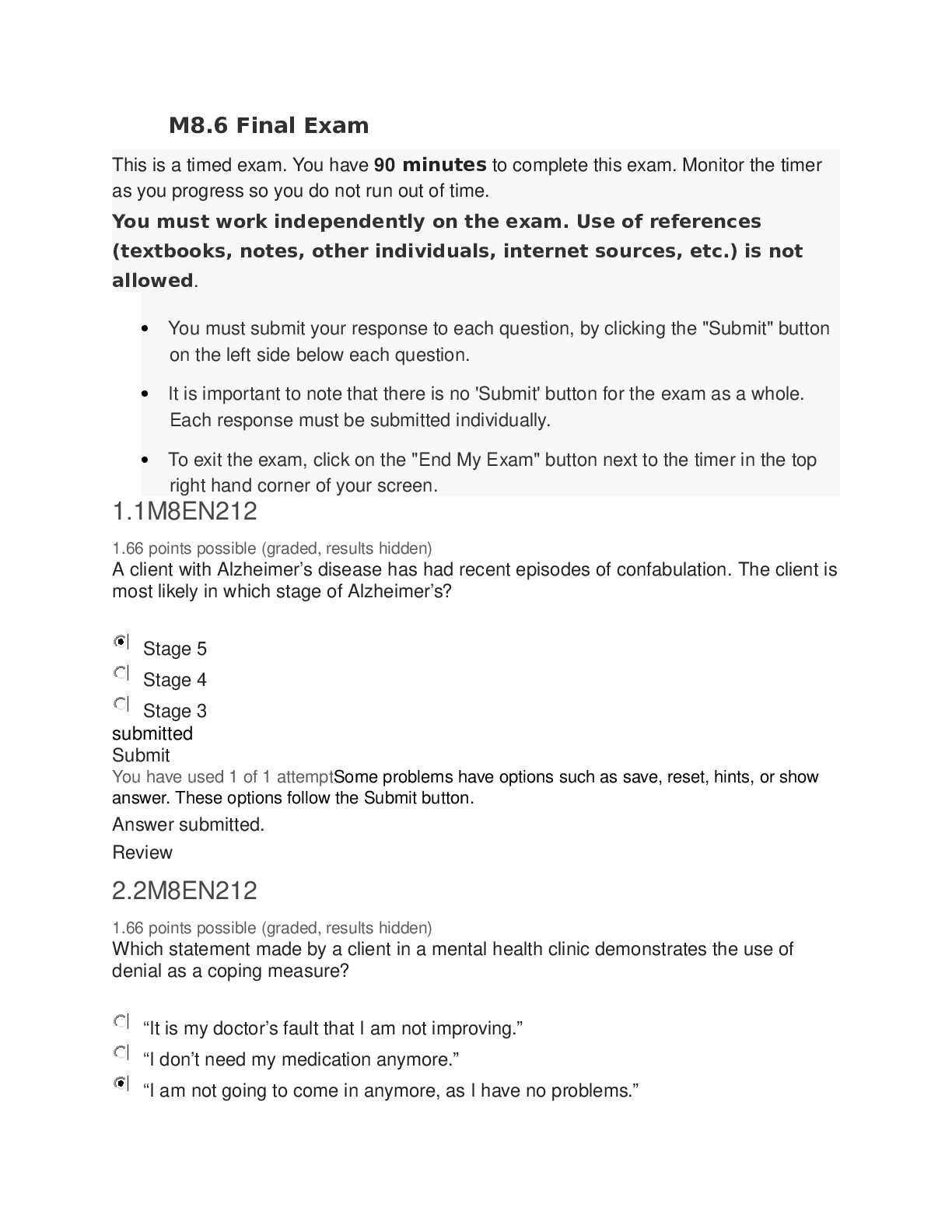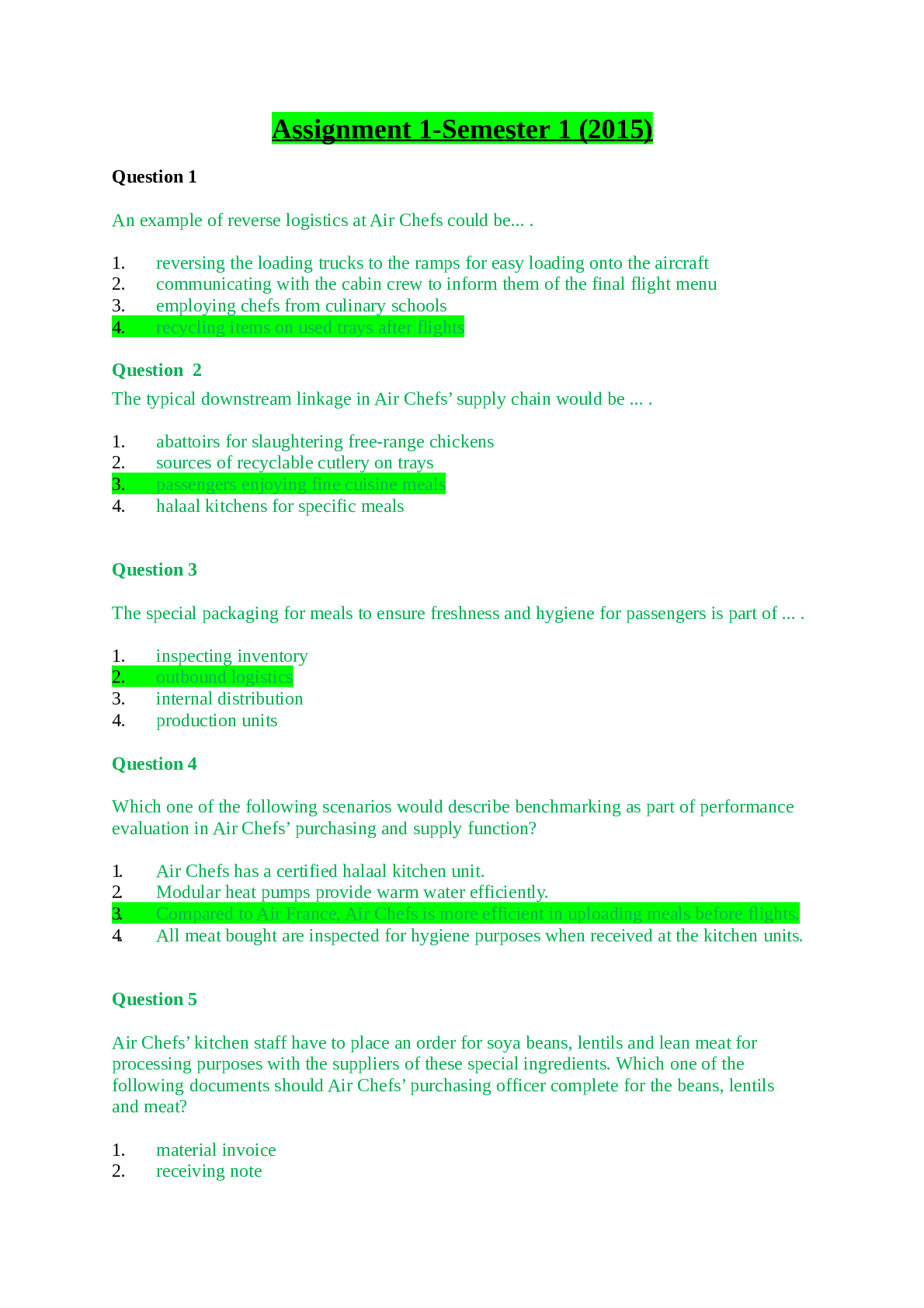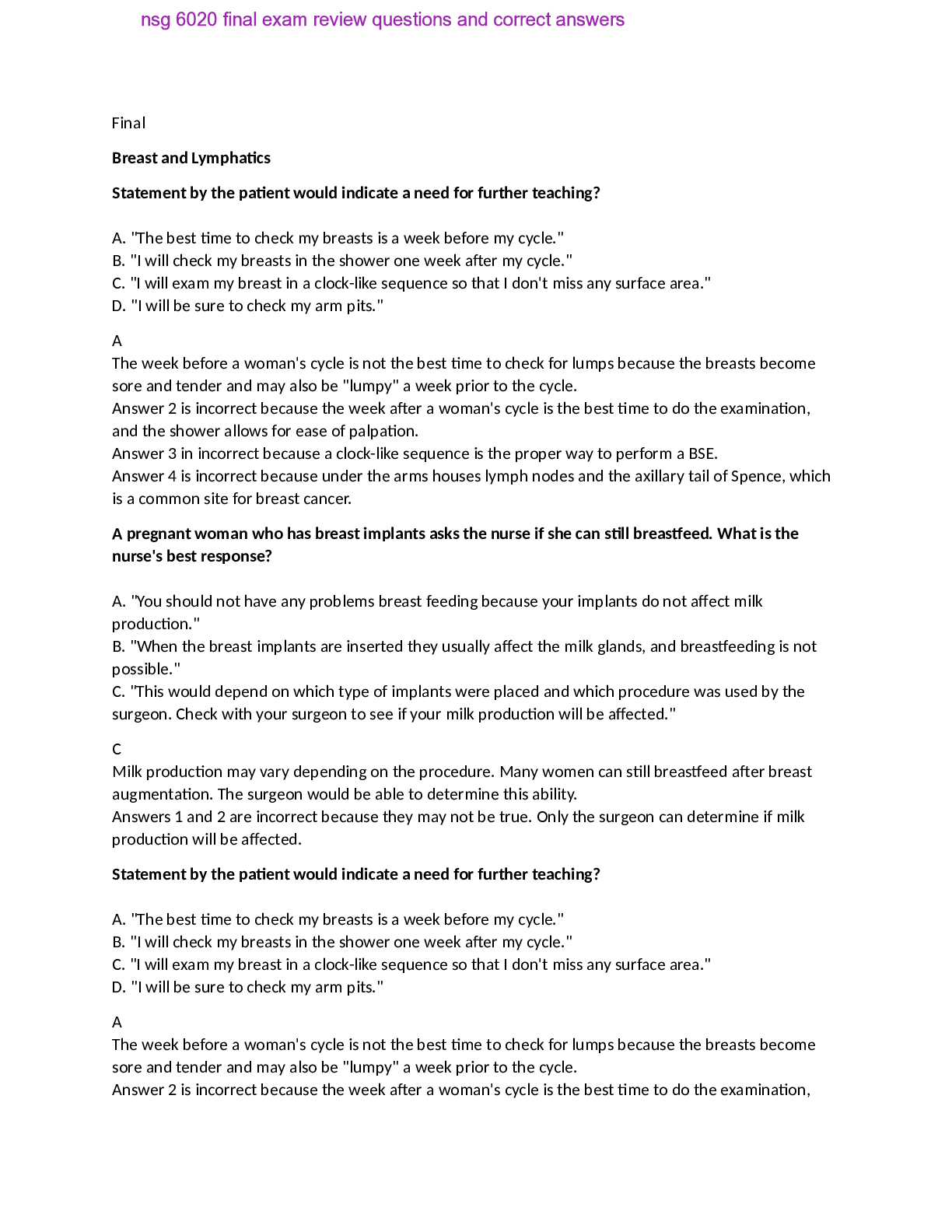*NURSING > Final Exam Review > ATI RN Pharmacology (8.0) Test Bank, Latest 2019/2020 complete solutions. Already rated grade A. (All)
ATI RN Pharmacology (8.0) Test Bank, Latest 2019/2020 complete solutions. Already rated grade A.
Document Content and Description Below
ATI RN Pharmacology (8.0) Chapter 1 1. A provider prescribes phenobarbital for a client wo has a seizure disorder. The medication has a long half-life of 4 days. How many times per day should the nurs... e expect to administer this medication? a. One b. Two c. Three d. Four 2. A nurse educator is reviewing medication metabolism at an in-service presentation. Which of the following factors should the educator include as a reason to administer lower medication dosages? (Select all that apply.) a. Increased renal excretion b. Increased medication-metabolizing enzymes c. Liver failure d. Peripheral vascular disease e. Concurrent use of medication the same pathway metabolizes 3. A nurse is preparing to administer eye drops to a client. Which of the following actions should the nurse take? (Select all that apply.) a. Have the client lie on one side. b. Ask the client to look up at the ceiling. c. Tell the client to blink when the drops enter the eye. d. Drop the medication into the client’s conjunctival sac. e. Instruct the client to close the eye gently after instillation. 4. A nurse is teaching a client about transdermal patches. Which of the following statements should the nurse identify as an indication that the client understands? a. “I will clean the site with an alcohol swab before I apply the patch.” b. “I will rotate the application sites weekly.” c. “I will apply the patch to an area of skin with no hair.” d. “I will place the new patch on the site of the old patch.” 5. A nurse reviewing a client’s medical record notes a new prescription for verifying the trough level of the client’s medication. Which of the following actions should the nurse take? a. Obtain a blood specimen immediately prior to administering the next dose of medication. b. Verify that the client has been taking the medication for 24hr before obtaining a blood specimen. c. Ask the client to provide a urine specimen after the next dose of medication. d. Administer the medication, and obtain a blood specimen 30 min later. Chapter 2 1. A nurse is preparing a client’s medications. Which of the following actions should the nurse take I following legal practice guidelines? (Select all that apply.) a. Teach the client about the medication. b. Determine the dosage. c. Monitor for adverse effects. d. Lock compartments for controlled substances. e. Determine the client’s insurance status. 2. A nurse is preparing to administer digoxin to a client who states, “I don’t want to take that medication. I do not want one more pill.” Which of the following responses should the nurse make? a. “Your physician prescribed it for you, so you really should take it.” b. “Well, let’s just get it over quickly then.” c. “Okay, I’ll just give you your other medications.” d. “Tell me our concerns about taking this medication.” 3. A nurse is reviewing a client’s prescribed medications. Which of the following situations represents a contraindication to medication administration? a. The client drank grapefruit juice, which could reduce a medication’s effectiveness. b. The medication has orthostatic hypotension as an adverse effect. c. A medication is approved for ages 12 and older, and the client is 8 years old. d. An antianxiety medication that has an adverse effect of drowsiness is prescribed as a preoperative sedative. 4. A nurse is assessing a client before administering medications. Which of the following data should the nurse obtain? (Select all that apply.) a. Use of herbal products b. Daily fluid intake c. Ability to swallow d. Previous surgical history e. Allergies 5. A nurse is working with a newly licensed nurse who is administering medications to clients. Which of the following actions should the nurse identify as an indication that the newly hired nurse understands medication error prevention? a. Taking all medications out of the unit-dose wrappers before entering the client’s room. b. Checking the prescription when a single dose requires administration of multiple tablets. c. Administering a medication, then looking the usual dosage range. d. Relying on another nurse to clarify a medication prescription. Chapter 3 1. A nurse is preparing to administer vancomycin 1g by intermittent IV bolus. Available is vancomycin 1g in 100 mL of dextrose 5% in water (D5W) to infuse over 45 min. the drop factor of the manual IV tubing is 10gtt/mL. The nurse should adjust the manual IV infusion to deliver how many gtt/min? (Round the answer to the nearest whole number. Do not use a trailing zero.) 22gtt/min 2. A nurse is preparing to administer clindamycin 200mg by intermittent IV bolus. The amount available is clindamycin injection 200mg in 100mL 0.9% NaCl to infuse over 30 min. The nurse should set the IV pump to deliver how many mL/hr? (Round to the nearest whole number. Do not use a trailing zero.) 200mL/hr 3. A nurse is preparing to administer furosemide 80mg PO daily. The amount available is furosemide oral solution 10mg/1mL. How many mL should the nurse administer? (Round to the nearest whole number. Do not use a trailing zero.) 8 mL 4. A nurse is preparing to administer haloperidol 2mg PO every 12 hr. The amount available is haloperidol 1mg/tablet. How many tablets should the nurse administer? (Round to the nearest whole number. Do not use a trailing zero.) 2 tablets 5. A nurse is preparing to administer amoxicillin 20mg/kg/day PO to divide equally every 12 hr to a preschooler who weighs 44lb. The amount available is amoxicillin suspension 250mg/5mL. How many mL should the nurse administer per dose? (Round to the nearest whole number. Do not use a trailing zero.) 4 mL 6. A nurse is preparing to administer heparin 15,000 units subcutaneously every 12 hr. The amount available is heparin injection 20,000 units/mL. How many mL should the nurse administer per dose? (Round to the nearest tenth. Do not use a trailing zero.) 0.8 mL 7. A nurse is preparing to administer acetaminophen 650mg PO every 6 hr PRN for pain. The amount available is acetaminophen liquid 500 mg/5mL. how many mL should the nurse administer per dose? (Round to the nearest tenth. Use a leading zero if applies. Do not use a trailing zero.) 6.5mL 8. A nurse is preparing to administer dextrose 5% in water (D5W) 750 mL IV to infuse over 6 hr. The nurse should set the IV pump to deliver how many mL/hr? (Round the answer to the nearest whole number. Do not use a trailing zero.) 125 mL/hr Chapter 4 1. A nurse is caring for a client experiencing IV extravasation. The facility requires the administration of an antidote for the prescribed IV solution. After stropping the IV infusion, which of the following actions should the nurse take first? a. Remove the IV catheter. b. Withdraw the solution from the IV access. c. Administer the antidote to the vesicant. d. Insert a new IV access in a different extremity. 2. A nurse is preparing to initiate IV therapy for an older adult client. Which of the following actions should the nurse plan to take? a. Use a disposable razor to remove excess hair on the extremity. b. Select the back of the client’s hand to insert the IV catheter. c. Distend the veins by using BP cuff. d. Direct the client to raise their arm above the heart. 3. A nurse assessing the IV catheter insertion site for a client receiving a nonvesicant solution and notes swelling at the site with decreased skin temperature. Which of the following actions should the nurse take? (Select all that apply.) a. Stop the infusion. b. Start a new IV access distal to this site. c. Apply warm compresses to the insertion. d. Elevate the client’s arm. e. Obtain a specimen for culture at the insertion site. Chapter 5 1. A nurse in a clinic is caring for a group of clients. The nurse should contact the provider about a potential contraindication to a medication for which of the following clients? (Select all that apply.) a. A client at 8 weeks of gestation who asks for an influenza immunization. b. A client who takes prednisone and has a possible fungal infection. c. A client who has chronic liver disease and is taking hydrocodone/acetaminophen. d. A client who has peptic ulcer disease, takes sucralfate, and has started taking OTC aluminum hydroxide. e. A client who has a prosthetic heart valve, takes warfarin, and reports suspected pregnancy. 2. A nurse is preparing to administer an IM dose of PCN to a client who has a new prescription. The client states when they took PCN 3 years ago, the developed a rash. Which of the following actions should the nurse take? a. Administer the prescribed dose. b. Withhold the medication. c. Ask the provider to change the prescription to an oral form. d. Administer an oral histamine at the same time. 3. A nurse is providing discharge instructions for a client who has a new prescription for an antihypertensive medication. Which of the following statements should the nurse give? a. “Be sure to limit your potassium intake while taking this medication.” b. “You should check your blood pressure every 8 hours while taking this medication.” c. “Your medication dosage will be increased if you develop tachycardia.” d. “Change positions slowly when you move from sitting to standing.” 4. A nurse is reviewing a client’s health record and notes that the client experienced permanent extrapyramidal effects caused by a previous medication. The nurse should recognize that the medication affected which of the following systems in the client? a. Cardiovascular b. Immune c. Central nervous d. Gastrointestinal 5. A nurse is caring for a client who is taking oral oxycodone. The client is also taking ibuprofen in three recommended doses daily. The nurse should identify that an interaction between these two medications will cause which of the following findings? a. A decrease in blood levels of ibuprofen, possibly leading to a need for increased doses of this medication. b. A decrease in blood levels of oxycodone, possibly leading to a need for increased doses of this medication. c. An increase in the expected therapeutic effect of both medications. d. An increase in expected adverse effects for both medications. Chapter 6 1. A nurse is preparing to administer medications to a 4-month-old infant. Which of the following pharmacokinetic principles should the nurse consider when administering medications to this client? (Select all that apply.) a. Infants have a more rapid gastric emptying time. b. Infants have immature liver function. c. Infants’ blood-brain barrier is poorly developed. d. Infants have an increased ability to absorb topical medications. e. Infants have an increased number of protein-binding sites. 2. A nurse in a provider’s office is reviewing the medical record of a client who is pregnant and at the first prenatal visit. Which of the following immunizations can the nurse administer safely to this client? a. Varicella vaccine b. Rubella vaccine c. Inactivated influenza vaccine d. Measles vaccine 3. A nurse on a medical-surgical unit administers a hypnotic medication to an older adult client at 2100. The next morning, the client is drowsy and wants to sleep instead of eating breakfast. Which of the following factors should the nurse identify as a possible reason for the client’s drowsiness? a. Reduced cardiac function b. First-pass effect c. Reduced hepatic function d. Increased gastric motility. Chapter 7 1. A nurse working in an emergency department is caring for a client who has benzodiazepine toxicity. Which of the following actions is the nurse’s priority? a. Administer flumazenil. b. Identify the client’s level of orientation. c. Infuse IV fluids. d. Prepare the client for gastric lavage. 2. A nurse is teaching a client who has a new prescription for escitalopram for treatment of generalized anxiety disorder. Which of the following statements by the client indicated understanding of the teaching? a. “I should take the medication on an empty stomach.” b. “I will follow a low-sodium diet while taking this medication.” c. “I need to discontinue this medication slowly.” d. “I should not crush this medication before swallowing.” 3. A nurse is providing teaching to a client who has a new prescription for buspirone to treat anxiety. Which of the following information should the nurse include? a. “Take this medication on an empty stomach.” b. “Expect optimal therapeutic effects within 24 hr.” c. “Take this medication when needed for anxiety.” d. “This medication has a low risk for dependency.” 4. A nurse is teaching a client who has obsessive-compulsive disorder and has a new prescription for paroxetine. Which of the following instructions should the nurse include? a. “It can take several weeks before you feel like the medication is helping.” b. “Take the medication just before bedtime to promote sleep.” c. “You should take the medication when needed for obsessive urges.” d. “Monitor for weight gain while taking this medication.” 5. A nurse is caring for a client who takes paroxetine to treat posttraumatic stress disorder and reports that they grind their teeth during the night. The nurse should identify which of the following interventions to manage bruxism? (Select all that apply.) a. Concurrent administration of buspirone b. Administration of different SSRI c. Use of mouth guard d. Changing to a different class of antidepressant medication e. Increasing the dose of paroxetine Chapter 8 1. A nurse is caring for a client who has a new prescription for phenelzine for the treatment of depression. Which of the following indicates that the client has developed and adverse effect of this medication? a. Orthostatic hypotension b. Hearing loss c. Gastrointestinal bleeding d. Weight loss 2. A nurse is providing teaching to a client who has a new prescription for amitriptyline for treatment of depression. Which of the following should the nurse include in the teaching? (Select all that apply.) a. Expect therapeutic effects in 24 to 48 hr. b. Discontinue the medication after a week of improved mood. c. Change positions slowly to minimize dizziness. d. Decrease dietary fiber intake to control diarrhea. e. Chew sugarless gum to prevent dry mouth. 3. A nurse is providing discharge teaching to a client who has a new prescription for fluoxetine for posttraumatic stress disorder. Which of the following statements should the nurse include in the teaching? a. “You can have a decreased desire for intimacy while taking this medication.” b. “You should take this medication at bedtime to help promote sleep.” c. “You will have fewer urinary adverse effects if you urinate just before taking this medication.” d. “You’ll need to wear sunglasses when outdoors due to the light sensitivity caused by this medication.” 4. A nurse is caring for a client who has depression and a new prescription for venlafaxine. The nurse should monitor the client for which of the following manifestation as an adverse effect of this medication? (Select all that apply.) a. Mydriasis b. Dizziness c. Decreased libido d. Alopecia e. Hypotension 5. A nurse is caring for a client who has been taking sertraline for the past 2 days. Which of the following assessment findings should alert the nurse to the possibility that the client is developing serotonin syndrome? a. Bruising b. Fever c. Tinnitus d. Rash Chapter 9 1. A nurse is reviewing laboratory findings and notes that a client’s lithium level is 2.1 mEq/L. Which of the following is an appropriate action by the nurse? a. Perform immediate gastric lavage. b. Prepare the client for hemodialysis. c. Administer an additional oral dose of lithium. d. Request a stat repeat of the laboratory test. 2. A nurse is caring for a client who has a new prescription for lithium carbonate. When teaching the client about ways to prevent lithium toxicity, the nurse should advise the client to do which of the following? a. Avoid the use of acetaminophen for headaches. b. Restrict intake of foods rich in sodium. c. Decrease fluid intake to less than 1,500 mL daily. d. Limit aerobic activity in hot weather. 3. A nurse is assessing a client who takes lithium carbonate for the treatment of bipolar disorder. The nurse should identify which of the following findings is a possible indication of toxicity to this medication? a. Severe hypertension b. Coarse tremors c. Constipation d. Muscle spasms 4. A nurse is caring for a client who has a new prescription for valproic acid. The nurse should instruct the client to have which of the following blood laboratory tests completed periodically? (Select all that apply.) a. Thrombocyte count b. Glucose c. Amylase d. Liver function tests e. Potassium 5. A nurse is preparing a teaching plan for a client who has bipolar disorder and a new prescription for carbamazepine. Which of the following instructions should the nurse include in the teaching? (Select all that apply.) a. “This medication can safely be taken during pregnancy.” b. “Eliminate grapefruit juice from your diet.” c. “You will need to have a complete blood count and carbamazepine levels drawn periodically.” d. “Notify you provider if you develop a rash.” e. “Avoid driving for the first few days after starting this medication.” Chapter 10 1. A nurse is teaching a client, who has schizophrenia, strategies to cope with anticholinergic effects of fluphenazine. Which of the following should the nurse suggest to the client to minimize anticholinergic effects? a. Take the medication in the morning to prevent insomnia. b. Chew sugarless gum to moisten the mouth. c. Use cooling measures to decrease fever. d. Take an antacid to relieve nausea. 2. A nurse is assessing a client who recently began taking haloperidol. Which of the following findings is the priority to report to the provider? a. Shuffling gait b. Neck spasms c. Drowsiness d. Sexual dysfunction 3. A nurse is providing discharge teaching to a client who has a new prescription for clozapine. Which of the following statements should the nurse include in the teaching? a. “You should have a high-carbohydrate snack between meals and at bedtime.” b. “You are likely to develop hand tremors if you take this medication for a long period of time.” c. “You may experience temporary numbness of your mouth after each dose.” d. “You should have your white blood cell count monitored every week.” 4. A nurse is providing teaching for a client who is to begin taking risperidone. Which of the following instructions should the nurse include? a. “Add extra snacks to your diet to prevent weight loss.” b. “Notify the provider if you have trouble sleeping.” c. “You may begin to have mild seizures while taking this medication.” d. “This medication is likely to increase your libido.” 5. A nurse is following up with a client who takes chlorpromazine for the treatment of schizophrenia. The nurse should expect to find the greatest improvement in which of the following manifestations? (Select all that apply.) a. Disorganized speech b. Bizarre behavior c. Impaired social interactions d. Hallucinations e. Decreased motivation Chapter 11 1. A nurse is teaching the guardians of a child who has a new prescription for desipramine. The nurse should include that which of the following adverse effects is the priority to report to the provider? a. Constipation b. Suicidal thoughts c. Photophobia d. Dry mouth. 2. A nurse is teaching an adolescent client who has a new prescription for clomipramine for OCD. Which of the following instructions should the nurse include to minimize an adverse effect of his medication? a. Wear sunglasses when outdoors. b. Check your temperature daily. c. Take this medication in the morning. d. Add extra calories to your diet. 3. A nurse is caring for a school-age child who has a new prescription for atomoxetine. The nurse should monitor the client for which of the following manifestations as an adverse effect of this medication? a. Kidney toxicity b. Liver damage c. Seizure activity d. Adrenal insufficiency 4. A nurse is teaching the caregiver of a school-age child about transdermal methylphenidate. Which of the following instructions should the nurse include? a. Apply one patch twice per day. b. Leave a patch on for 9 hr. c. Apply the patch to the child’s waist. d. Use opened tray within 6 months. 5. A nurse is teaching the guardians and their school-age child about a new prescription for lisdexamfetamine. Which of the following information should the nurse include in the training? (Select all that apply). a. An adverse effect of this medication is CNS stimulation. b. Administer the medication before bedtime. c. Monitor blood pressure while taking this medication. d. Therapeutic effects of this medication will take 1 to 3 weeks to fully develop. e. This medication raises the levels of dopamine in the brain. Chapter 12 1. A nurse is providing teaching for a client who is withdrawing from alcohol and has a new prescription for propranolol. Which of the following information should the nurse include in the teaching? a. Increases the risk for seizure activity. b. Provides a for of aversion therapy. c. Decreases cravings. d. Can increase blood pressure. 2. A charge nurse is planning a staff education session to discuss medications used during the care of a client experiencing alcohol withdrawal. Which of the following medications should the charge nurse include in the discussion? (Select all that apply.) a. Lorazepam b. Diazepam c. Disulfiram d. Naltrexone e. Acamprosate 3. A nurse is teaching a client who has a new prescription for clonidine to assist with maintenance of abstinence form opioids. The nurse should instruct the client to monitor for which of the following adverse effects? a. Diarrhea b. Dry mouth c. Insomnia d. Hypertension 4. A nurse is teaching a client who has tobacco use disorder about nicotine replacement therapy. Which of the following statements by the client indicates understanding of the teaching? a. “I should avoid eating right before I chew a piece of nicotine gum.” b. “I will need to stop using the nicotine gum after 1 year.” c. “I know that nicotine gum is a safe alternative to smoking if I become pregnant.” d. “I must chew the nicotine gum quickly for about 15 minutes.” 5. A nurse in an acute mental health facility is caring for a client who is experiencing withdrawal from opioid use and has a new prescription for clonidine. Which of the following actions should the nurse identify as the priority? a. Administer the clonidine on the prescribed schedule. b. Provide ice chips at the client’s bedside. c. Educate the client on the effects of clonidine. d. Obtain baseline vital signs. Chapter 13 1. A nurse in the post-anesthesia recovery unit is caring for a client who received a nondepolarizing neuromuscular blocking agent and has muscle weakness. The nurse should expect a prescription for which of the following medications? a. Neostigmine b. Naloxone c. Dantrolene d. Vecuronium 2. A nurse is providing information to a client who has early Parkinson’s disease and a new prescription for pramipexole. The nurse should instruct the client to monitor for which of the following adverse effects of this medication? a. Hallucinations b. Increased salivation c. Diarrhea d. Discoloration of urine 3. A nurse is teaching a client who has a new prescription for levodopa/carbidopa for Parkinson’s disease. Which of the following instructions should the nurse include? a. Increase intake of protein-rich foods b. Expect muscle twitching to occur c. Take this medication with food d. Anticipate relief of manifestations in 24 hr 4. A nurse is preparing to administer a medication to a client who has absence seizures. The nurse should expect to administer which of the following medications to the client? (Select all that apply.) a. Phenytoin b. Ethosuximide c. Gabapentin d. Carbamazepine e. Valproic acid 5. A nurse is reviewing a new prescription for oxcarbazepine with a client who has partial seizures. Which of the following instructions should the nurse include? (Select all that apply.) a. “Use caution if given a prescription for a diuretic medication.” b. “Consider using an alternate form of contraception if you are using oral contraceptives.” c. “Chew gum to increase saliva production.” d. “Avoid driving until you see how the medication affects you.” e. “Notify your provider if you develop skin rash.” Chapter 14 1. A nurse is instructing a client who has a new prescription for timolol how to insert eye drops. The nurse should instruct the client to press on which of the following area to prevent systemic absorption of the medication? a. Bony orbit b. Nasolacrimal duct c. Conjunctival sac d. Outer canthus 2. A nurse is teaching a client who has a new prescription for brimonidine ophthalmic drops and wears soft contact lenses. Which of the following instructions should the nurse include in the teaching? a. “This medication can stain your contacts.” b. “This medication can cause your pupils to constrict.” c. “This medication can absorb into your contacts.” d. “This medication can slow your heart rate.” 3. A nurse in an emergency department is reviewing the medical record of a client who is being evaluated for angle-closure glaucoma. Which of the following findings are indicative of this condition? a. Insidious onset of painless loss of vision b. Gradual reduction in peripheral vision c. Severe pain around eyes d. Intraocular pressure 12mmHg 4. A nurse is teaching a client about preventing otitis externa. Which of the following instructions should the nurse include? a. Clean the ear with a cotton-tipped swab daily. b. Place earplugs in the ears when sleeping at night. c. Use a cool water irrigation solution to remove earwax. d. Tip the head to the side to remove water from the ears after showering. 5. A nurse in a provider’s office is instructing a guardian of a toddler how to administer ear drops. Which of the following instructions should the nurse include? (Select all that apply.) a. “Place the child on the unaffected side when you are ready to administer the medication.” b. “Warm the medication by gently rolling it between your hands for a few minutes.” c. “Gently shake medication that is in suspension form.” d. “Keep the child on their side for 5 minutes after instillation of the ear drops.” e. “Tightly pack the ear with cotton after instillation of the ear drops.” Chapter 15 1. A nurse in the operating room is caring for a client who received a dose of succinylcholine. During the operation, the client suddenly develops rigidity and a rise in body temperature. The nurse should expect a prescription for which of the following medications? a. Neostigmine b. Naloxone c. Dantrolene d. Vecuronium 2. A nurse is the post-anesthesia care unit is caring for a client who is experiencing malignant hyperthermia. Which of the following actions should the nurse take? (Select all that apply.) a. Place a cooling blanket on the client. b. Administer oxygen at 100%. c. Administer iced 0.9% sodium chloride. d. Administer potassium chloride IV. e. Monitor core body temperature. 3. A nurse is teaching a client who has a new prescription for baclofen to treat muscle spasms. Which of the following statements by the client indicates an understanding of the teaching? (Select all that apply.) a. “I will stop taking this medication right away if I develop dizziness.” b. “I know the doctor will gradually increase my dose of this medication for a while.” c. “I should increase fiber to prevent constipation from this medication.” d. “I won’t be able to drink alcohol while I’m taking this medication.” e. “I should take this medication on empty stomach each morning.” 4. A nurse is reviewing the medical record of a client who reports urinary incontinence ad asks about a prescription for oxybutynin. The nurse should recognize that oxybutynin is contraindicated in the presence of which of the following conditions? a. Bursitis b. Sinusitis c. Depression d. Glaucoma 5. A nurse is assessing a client who has a prescription for bethanechol for urinary retention. The nurse should identify that which of the following findings is a manifestation of muscarinic stimulation? a. Dry mouth b. Hypertension c. Excessive perspiration d. Fecal impaction Chapter 16 1. A nurse is providing instructions to a client who has been experiencing insomnia and has a new prescription for temazepam. The nurse should inform the client that which of the following manifestations are adverse effects of temazepam? (Select all that apply.) a. Incoordination b. Hypertension c. Pruritus d. Sleep driving e. Amnesia 2. A nurse is caring for a client who is receiving moderate sedations with diazepam IV. The client is oversedated. Which of the following medications should the nurse expect to administer to this client? a. Ketamine b. Naltrexone c. Flumazenil d. Fluvoxamine 3. A nurse is teaching a client who has a new prescription for ramelteon. The nurse should instruct the client to avoid which of the following foods at the time of medication administration? a. Baked potato b. Fried chicken c. Whole-grain bread d. Citrus fruit 4. A nurse is caring for a client who is undergo a surgical procedure. Which of the following preexisting conditions can be a contraindication for the use of ketamine as an IV anesthetic? a. Peptic ulcer disease b. Breast cancer c. Diabetes mellitus d. Schizophrenia 5. A nurse is providing instructions to a client who has a new prescription for zolpidem. Which of the following instructions should the nurse include? a. “Notify the provider if you plan to become pregnant.” b. “Take the medication 1 hr before you plan to go to sleep.” c. “Allow at least 6 hr for sleep when taking zolpidem.” d. “To increase the effectiveness of zolpidem, take it with a bedtime snack.” Chapter 17 1. A nurse is teaching a client who has a new prescription for beclomethasone. Which of the following instructions should the nurse include? a. “Rinse your mouth after each use of this medication.” b. “Limit fluid intake while taking this medication.” c. “Increase your intake of vitamin B12 while taking this medication.” d. “You can take the medication as needed.” 2. A nurse is providing instructions to a client who has a new prescription for albuterol and beclomethasone inhalers for the control of asthma. Which of the following instructions should the nurse include in the teaching? a. Take the albuterol at the same time each day. b. Administer the albuterol inhaler prior to using the beclomethasone inhaler. c. Use beclomethasone if experiencing an acute episode. d. Avoid shaking the beclomethasone before use. 3. A nurse is providing instructions to a client who has a new prescription for albuterol, PO. Which of the following instructions should the nurse include? a. “You can take this medication to abort an acute asthma attack.” b. “Tremors are an adverse effect of this medication.” c. “Prolonged use of this medication can cause hyperglycemia.” d. “This medication can slow skeletal growth rate.” 4. A nurse is teaching a client who has a prescription for long-term use of oral prednisone for treatment of chronic asthma. The nurse should instruct the client to monitor for which of the following manifestations as an adverse effect of this medication? a. Weight gain b. Nervousness c. Bradycardia d. Constipation Chapter 18 1. A nurse is caring for a client who has been taking phenylephrine nasal drops for the past 10 days for sinusitis. The nurse should assess the client for which of the following manifestations as an adverse effect of this medication? a. Sedation b. Nasal congestion c. Productive cough d. Constipation 2. A nurse is teaching a client who has a new prescription for dextromethorphan to suppress a cough. The nurse should instruct the client to monitor for which of the following manifestations as an adverse effect of this medication? a. Diarrhea b. Anxiety c. Sedation d. Palpitations 3. A nurse is teaching the family of a child who has cystic fibrosis and a new prescription for acetylcysteine. Which of the following information should the nurse include in the instructions? a. “Expect this medication to suppress your child’s cough.” b. “Expect this medication to smell like rotten eggs.” c. “Expect this medication to cause euphoria.” d. “Expect this medication to turn your child’s urine orange.” 4. A nurse is teaching a client who has a new prescription for diphenhydramine for allergic rhinitis. The nurse should instruct the client to monitor for which of the following manifestations as an adverse effect of this medication? (Select all that apply.) a. Dry mouth b. Nonproductive cough c. Skin rash d. Drowsiness e. Urinary hesitation 5. A nurse is teaching a client about the use of fluticasone to treat perennial rhinitis. Which of the following statements by the client indicates an understanding of the teaching? a. “I should use the spray every 4 hours while I am awake.” b. “It can take as long as 3 weeks before the medication takes a maximum effect.” c. “This medication can also be used to treat motion sickness.” d. “I can use this medication when my nasal passages are blocked.” Chapter 19 1. A nurse is planning care for a client who is receiving furosemide IV for peripheral edema. Which of the following intervention should the nurse include in the plan of care? (Select all that apply.) a. Assess for tinnitus. b. Report output 50 mL/hr. c. Monitor blood potassium levels. d. Elevate the head of bed slowly before ambulation. e. Recommend eating a banana daily. 2. A nurse is providing information to a client who has a new prescription for hydrochlorothiazide. Which of the following information should the nurse include? a. Take the medication with food. b. Plan to take the medication at bedtime. c. Expect increased swelling of the ankles. d. Fluid intake should be limited in the morning. 3. A nurse is monitoring a client who is receiving spironolactone. Which of the following findings should the nurse report to the provider? a. Blood sodium 144 mEq/L b. Urine output 120 mL in 4 hr c. Blood potassium 5.2 mEq/L d. Blood pressure 140/90 mmHg 4. A nurse is caring for a client who has increased intracranial pressure and is receiving mannitol. Which of the following findings should the nurse report to the provider? a. Blood glucose 150 mg/dL b. Urine output 40 mL/hr c. Dyspnea d. Bilateral equal pupil size 5. A nurse is planning care for a client who has a new prescription for torsemide. The nurse should plan to monitor for which of the following conditions as potential adverse reactions of this medication? (Select all that apply.) a. Respiratory acidosis b. Hypokalemia c. Hypotension d. Ototoxicity e. Ventricular dysrhythmias Chapter 20 1. A nurse is reviewing the health record of a client who asks about using propranolol to treat HTN. The nurse should recognize which of the following conditions is a contraindication for taking propranolol? a. Asthma b. Glaucoma c. Hypertension d. Tachycardia 2. A nurse is teaching a client who has a new prescription for verapamil to control HTN. Which of the following instructions should the nurse include? a. Increased the amount of fiber in the diet. b. Drink grapefruit juice daily to increase vitamin C intake. c. Decrease the amount of calcium in the diet. d. Withhold food for 1 hr after the medication is taken. 3. A nurse is caring for a client who has a new prescription for captopril for HTN. The nurse should monitor the client for which of the following as an adverse effect of this medication? a. Hypokalemia b. Hypernatremia c. Neutropenia d. Bradycardia 4. A nurse in an acute care facility is caring for a client who is receiving IV nitroprusside for hypertensive crisis. Which of the following conditions should the nurse monitor the client for as an adverse effect of this medication? a. Intestinal ileus b. Neutropenia c. Delirium d. Hyperthermia 5. A nurse is planning to administer a first dose of captopril to a client who has HTN. Which of the following medications can intensify first dose hypotension? (Select all that apply.) a. Simvastatin b. Hydrochlorothiazide c. Phenytoin d. Clonidine e. Aliskiren Chapter 21 1. A nurse in a provider’s office is monitoring blood electrolytes for four clients who take digoxin. Which of the following electrolyte values increases a client’s risk for digoxin toxicity? a. Calcium 9.2 mg/dL b. Calcium 10.3 mg/dL c. Potassium 3.4 mEq/L d. Potassium 4.8 mEq/L 2. A nurse is caring for a client who has a new prescription for digoxin and takes multiple other medications. The nurse should recognize that concurrent use of which of the following medications places the client at risk for digoxin toxicity? a. Phenytoin b. Verapamil c. Warfarin d. Aluminum hydroxide 3. A nurse is administering a dopamine infusion at a low dose to a client who has severe heart failure. Which of the following findings is an expected effect of this medication? a. Lowered heart rate b. Increased urine output c. Decreased conduction through the AV node d. Vasoconstriction of renal blood vessels 4. A nurse is providing teaching to a client who has a new prescription for digoxin. The nurse should instruct the client to monitor and report which of the following adverse effects that is a manifestation of digoxin toxicity? (Select all that apply.) a. Fatigue b. Constipation c. Anorexia d. Rash e. Blurred vision 5. A nurse is teaching a client who has a new prescription for digoxin to treat heart failure. Which of the following instructions should the nurse include in the teaching? a. Contact provider if HR is less than 60/min. b. Check pulse rate and multiply result by 2. c. Increase intake of sodium. d. Take with food if nausea occurs. Chapter 22 1. A nurse is teaching a client who has angina pectoris and is learning to treat acute anginal attacks. The client asks, “What is my next step if I take one tablet, wait 5 minutes, but still have anginal pain?” Which of the following responses should the nurse make? a. “Take two more sublingual tablets at the same time.” b. “Call the emergency response team.” c. “take a sustained-release nitroglycerin capsule.” d. “Wait another 5 minutes then take a second sublingual tablet.” 2. A nurse is teaching a client who has a new prescription for nitroglycerin transdermal patch for angina pectoris. Which of the following instructions should the nurse include? a. Remove the patch each evening. b. Cut each patch in half if angina attacks are under control. c. Take off the nitroglycerin patch for 30 min if a headache occurs. d. Apply a new patch every 48 hr. 3. A nurse is taking a medication history from a client who has angina and is to begin taking ranolazine. The nurse should report which of the following medications in the client’s history that can interact with ranolazine? (Select all that apply.) a. Digoxin b. Simvastatin c. Verapamil d. Amlodipine e. Nitroglycerin transdermal patch 4. A nurse is caring for a client who is prescribed isosorbide mononitrate for chronic stable angina and develops reflex tachycardia. Which of the following medications should the nurse expect to administer? a. Furosemide b. Captopril c. Ranolazine d. Metoprolol 5. A nurse is teaching a client who has angina how to use nitroglycerin transdermal ointment. The nurse should include which of the following instructions? a. “Remove the prior dose before applying a new dose.” b. “Rub the ointment directly into your skin until it is no longer visible.” c. “Cover the applied ointment with a clean gauze pad.” d. “Apply the ointment to the same sin area each time.” Chapter 23 1. A nurse is assessing a client who is taking amiodarone to treat atrial fibrillation. Which of the following findings is a manifestation of amiodarone toxicity? a. Light yellow urine b. Report of tinnitus c. Productive cough d. Blue-gray skin discoloration 2. A nurse is caring for a client who received IV verapamil to treat supraventricular tachycardia (SVT). The client’s pulse rate is now 98/min and the BP is 74/44 mmHg. The nurse should expect a prescription for which of the following IV medications? a. Calcium gluconate b. Sodium bicarbonate c. Potassium chloride d. Magnesium sulfate 3. A nurse is assessing a client who is taking digoxin to treat heart failure. Which of the following findings is a manifestation of digoxin toxicity? a. Bruising b. Report of metallic taste c. Muscle pain d. Report of anorexia 4. A nurse is assessing a client who has taken procainamide to treat dysrhythmias for the last 12 months. The nurse should assess the client for which of the following manifestations as an adverse effect of this medication? (Select all that apply.) a. HTN b. Widened QRS complex c. Narrowed QT interval d. Easy bruising e. Swollen joints 5. A nurse is preparing to administer propranolol to a client who has a dysrhythmia. Which of the following actions should the nurse plan to take? a. Hold propranolol for an apical pulse greater than 100/min. b. Administer propranolol to increase the client’s BP. c. Assist the client when sitting up or standing after taking this medication. d. Check for hypokalemia frequently due to the risk for propranolol toxicity. Chapter 24 1. A nurse is providing teaching to a client who is starting simvastatin. Which of the following information should the nurse include in the teaching? a. Take this medication in the evening. b. Change position slowly when rising from a chair. c. Maintain a steady intake of green leafy vegetables. d. Consume no more than 1 L/day of fluid. 2. A nurse is collecting data from a client who is taking gemfibrozil. Which of the following assessment findings should the nurse identify as an adverse effect of this medication? a. Mental status changes b. Tremor c. Jaundice d. Pneumonia 3. A nurse is teaching a client who is taking digoxin and has a new prescription for colesevelam. Which of the following instructions should the nurse include in the teaching? a. “Taking digoxin with your morning dose of colesevelam.” b. “Your sodium and potassium levels will be monitored periodically while taking colesevelam.” c. “Watch for bleeding or bruising while taking colesevelam.” d. “Take colesevelam with food and at least one glass of water.” 4. A nurse is completing a nursing history for a client who takes simvastatin. The nurse should identify which of the following disorders as a contraindication to adding ezetimibe to the client’s medications? a. History of severe constipation b. History of HTN c. Active hepatitis C d. Type 2 DM 5. A nurse is caring for a client who has a new prescription for alirocumab to reduce cholesterol. The nurse should monitor for which of the following findings as an adverse effect of alirocumab? (Select all that apply.) a. Muscle aches b. Vasculitis c. Hearing loss d. Urticaria e. Jaundice Chapter 25 1. A nurse is planning to administer subcutaneous 40 mg using a prefilled syringe of enoxaparin 40 mg/0.4 mL to an adult client following hip arthroplasty. Which of the following actions should the nurse plan to take? a. Expel air bubble from the prefilled syringe before injecting. b. Insert the needle completely into the client’s tissue. c. Administer the injection in the client’s thigh. d. Aspirate carefully after inserting the needle into the client’s skin. 2. A nurse is caring for a client who is receiving heparin by continuous IV infusion. The client begins vomiting blood, after the heparin has been stopped, which of the following medications should the nurse prepare to administer? a. Vitamin K b. Atropine c. Protamine d. Calcium gluconate 3. A nurse is planning to administer IV alteplase to a client. Which of the following interventions should the nurse plan to take? a. Administer IM enoxaparin along with the alteplase dose. b. Obtain the client’s weight. c. Administer aminocaproic acid IV prior to alteplase infusion. d. Prepare to administer alteplase within 8 hr of manifestation onset. 4. A nurse is monitoring a client who take aspirin daily. The nurse should identify which of the following manifestations as adverse effects of aspirin? (Select all that apply.) a. Hypertension b. Coffee-ground emesis c. Tinnitus d. Paresthesias of the extremities e. Nausea 5. A nurse is caring for a client who has atrial fibrillation and a new prescription for dabigatran. Which of the following medications is prescribed concurrently to treat an adverse effect of dabigatran? a. Vitamin K b. Protamine c. Omeprazole d. Probenecid Chapter 26 1. A nurse is caring for a client who is receiving daily doses of oprelvekin. Which of the following laboratory values should the nurse monitor to determine effectiveness of this medication? a. Hemoglobin b. Absolute neutrophil count c. Platelet count d. Total white blood count 2. A nurse is preparing to administer filgrastim for the first time to a client who has just undergone a bone marrow transplant. Which of the following actions should the nurse take? a. Administer IM in a large muscle mass to prevent injury. b. Ensure that the medication is refrigerated until just prior to administration. c. Shake vial gently to mix well before withdrawing dose. d. Discard vial after removing one dose of the medication. 3. A nurse is monitoring a client who is receiving epoetin alfa for adverse effects. The nurse should identify which of the following findings as an adverse effect of this medication? (Select all that apply.) a. Leukocytosis b. Hypertension c. Edema d. Blurred vision e. Headache 4. A nurse is assessing a client who has chronic neutropenia and has been receiving filgrastim. Which of the following actions should the nurse take to assess for an adverse effect of filgrastim? a. Assess for bone pain. b. Assess for right lower quadrant pain. c. Auscultate for crackles in the bases of the lungs. d. Auscultate the chest to listen for a heart murmur. Chapter 27 1. A nurse is preparing to administer a transfusion of 300 mL of pooled platelets to a client who has severe thrombocytopenia. The nurse should plan to administer the transfusion over which of the following time frames? a. Within 30 min/unit b. Within 60 min/unit c. Within 2 hr/unit d. Within 4 hr/unit 2. A nurse is transfusing a unit of packed RBCs to a client who has anemia due to chemotherapy. The client reports a sudden headache and chills. The client’s temperature is 2oF higher than the baseline reading. In addition to notifying the provider, which of the following actions should the nurse take? (Select all that apply.) a. Stop the transfusion. b. Place the client in an upright position with feet down. c. Remove the blood bad and tubing from the IV catheter. d. Obtain a urine specimen. e. Infuse dextrose 5% in water through the IV. 3. A nurse is preparing to transfuse a unit of packed RBCs to a client who has severe anemia. Which of the following interventions can prevent an acute hemolytic reaction? a. Ensure that the client has a patent IV line before obtaining blood product from the refrigerator. b. Obtain help from another nurse to confirm the correct client and blood product. c. Take a complete set of vital signs before beginning transfusion and periodically during the transfusion. d. Stay with the client for the first 15 to 30 min of the transfusion. 4. A nurse is caring for a client who has an aPTT greater than 1.5 times the expected reference range. Which of the following blood products should the nurse prepare to transfuse? a. Whole blood b. Platelets c. Fresh frozen plasma d. Packed RBCs 5. A nurse is assessing a client during transfusion of a unit of whole blood. The client develops a cough, SOB, elevated BP, and distended neck veins. The nurse should expect a prescription for which of the following medications? a. Epinephrine b. Lorazepam c. Furosemide d. Diphenhydramine Chapter 28 1. A nurse is teaching a client who will begin takin aluminum hydroxide. Which of the following information should the nurse include in the teaching? a. “If constipation develops, switch to a calcium-based antacids.” b. “Take this medication two hours before or after other medications.” c. “This medication increased the risk for pneumonia.” d. “Have your magnesium level monitored while taking this medication.” 2. A nurse is teaching a client who has a new prescription for omeprazole. Which of the following information should the nurse include in the teaching? a. Take this medication at bedtime. b. This medication decreases the production of gastric acid. c. Take this medication 2 hr after eating. d. This medication can cause hyperkalemia. 3. A nurse is teaching a client who takes phenytoin and has a new prescription for sucralfate tablets. Which of the following instructions should the nurse include? a. Take an antacid with sucralfate. b. Take sucralfate with a glass of milk. c. Allow a 2-hr interval between these medications. d. Chew the sucralfate thoroughly before swallowing. 4. A nurse is caring for four clients who have PUD. The nurse should identify misoprostol is contraindicated for which of the following clients? a. A client who is pregnant b. A client who has osteoarthritis c. A client who has a kidney stone d. A client who has a UTI 5. A nurse is teaching a client about cimetidine. Which of the following are adverse effects of cimetidine? (Select all that apply.) a. Increased libido b. Insomnia c. Enlargement of breast tissue d. Confusion e. Decreased sperm count Chapter 29 1. A nurse is caring for a client who received prochlorperazine 4 hr ago. The client reports spasms of the face. The nurse should expect a prescription for which of the following medications? a. Fomepizole b. Naloxone c. Phytonadine d. Diphenhydramine 2. A nurse is planning to administer ondansetron to a client. For which of the following adverse effects of ondansetron should the nurse monitor? (Select all that apply.) a. Headache b. Diarrhea c. Shortened PR interval d. Hyperglycemia e. Prolonged QT interval 3. A nurse is providing instructions about the use of laxatives to a client who has HF. The nurse should tell the client to avoid which of the following laxatives? a. Sodium phosphate b. Psyllium c. Bisacodyl d. Polyethylene glycol 4. A nurse is caring for a client who has diabetes and is experiencing nausea due to gastroparesis. The nurse should expect a prescription for which of the following medications? a. Lubiprostone b. Metoclopramide c. Bisacodyl d. Loperamide 5. A nurse is teaching a client about probiotic supplements. Which of the following information should the nurse include? (Select all that apply.) a. “Probiotics are micro-organisms that are normally found in the GI tract.” b. “Probiotics are used to treat Clostridium difficile.” c. “Probiotics are used to treat BPH.” d. “You can experience bloating while taking probiotic supplements.” e. “If you are prescribed an antibiotic, you should take it at the same time you take your probiotic supplement.” Chapter 30 1. A nurse is teaching a client who has anemia and a new prescription for a liquid iron supplement. Which of the following information should the nurse include in the teaching? (Select all that apply.) a. “Add foods that are high in fiber to your diet.” b. “Rinse your mouth after taking the medication.” c. “Expect stools to be green or black in color.” d. “Take this medication with a glass of milk.” e. “Add red meat to your diet.” 2. A nurse is assessing a client who is receiving magnesium sulfate and notes the client has depressed deep tendon reflexes. The nurse should expect to administer which of the following medications? a. Potassium chloride b. Folic acid c. Calcium gluconate d. Cyanocobalamin 3. A nurse is evaluating a group of clients at a health fair to identify the need for folic acid therapy. Which of the following clients require folic acid therapy? (Select all that apply.) a. 12-year-old child who has iron deficiency anemia b. 24-year-old female who has no health problems c. 44-year-old male who has HTN d. 55-year-old female who has alcohol use disorder e. 35-year-old male who has DM 2 4. A nurse is preparing to administer potassium chloride IV to a client who has hypokalemia. Which of the following actions should the nurse take? (Select all that apply.) a. Infuse medication through a large-bore needle. b. Monitor urine output to ensure at least 20 mL/hr. c. Administer medication via direct IV bolus. d. Implement cardiac monitoring. e. Administer the infusion using an IV pump. 5. A nurse is caring for a client who is receiving IV potassium. The nurse should monitor the client for which of the following manifestations as an indication of hyperkalemia? a. Tachycardia b. Dyspnea c. Lethargy d. Increased thirst Chapter 31 1. A nurse is reviewing the health care record of a client who is asking about conjugated equine estrogens. The nurse should inform the client this medication is contraindicated in which of the following conditions? a. Atrophic vaginitis b. Dysfunctional uterine bleeding c. Osteoporosis d. Thrombophlebitis 2. A nurse is providing teaching to a female client who is taking testosterone to treat advanced breast cancer. The nurse should tell the client that which of the following are adverse effects of this medication? (Select all that apply.) a. Deepening voice b. Weight gain c. Low blood pressure d. Dry mouth e. Facial hair 3. A nurse is explaining the mechanism of action of combination oral contraceptives to a group of clients. The nurse should tell the clients that which of the following actions occur with the use of combination oral contraceptives? (Select all that apply.) a. Thickening the cervical mucus b. Inducing maturation of ovarian follicle c. Increasing development of the corpus luteum d. Altering the endometrial lining e. Inhibiting ovulation 4. A nurse is providing teaching to a client who will start alfuzosin for treatment of BPH. The nurse should instruct the client that which of the following is an adverse effect of this medication? a. Bradycardia b. Edema c. Hypotension d. Tremor 5. A nurse is caring for a client who has angina and asks about obtaining a prescription for sildenafil to treat erectile dysfunction. Which of the following medications is contraindicated with sildenafil? a. Aspirin b. Isosorbide c. Clopidogrel d. Atorvastatin Chapter 32 1. A nurse is teaching a client about terbutaline. Which of the following statements by the client indicates understanding of the teaching? a. “This medication will stop my contractions.” b. “This medication will prevent vaginal bleeding.” c. “This medication will promote blood flow to my baby.” d. “This medication will increase my prostaglandin production.” 2. A nurse is caring for a client who has preeclampsia and is receiving magnesium sulfate IV continuous infusion. Which of the following findings should the nurse report to the provider? a. 2 deep tendon reflexes b. 2 pedal edema c. 24 mL/hr urinary output d. Respirations 12/min 3. A nurse is caring for a client who has a new prescription for oxytocin to stimulate uterine contractions. Which of the following actions should the nurse take? (Select all that apply.) a. Use an infusion pump for medication administration. b. Obtain vital signs frequently and with every dosage change. c. Stop infusion if uterine contractions occur every 4 min and last 45 seconds. d. Increase medication infusion rapidly. e. Monitor fetal heart rate continuously. 4. A nurse is caring for a client who is in labor and is receiving oxytocin. The nurse should monitor the client for which of the following as complications of oxytocin? a. Uterine rupture b. Uterine tachysystole c. Placental abruption d. Hyponatremia e. Placenta previa 5. A nurse is reviewing a new prescription for terbutaline with a client who has a history of preterm labor. Which of the following client statements indicates understanding of the teaching? a. “I can increase my activity now that I’ve started on this medication.” b. “I will increase my daily fluid intake to 3 quarts.” c. “I will report increasing intensity of contractions to my doctor.” d. “I am glad this will prevent preterm labor.” Chapter 33 1. A nurse is providing teaching for a client who has gout and a new prescription for allopurinol. For which of the following adverse effects should the client be taught to monitor? (Select all that apply.) a. Stomatitis b. Insomnia c. Nausea d. Rash e. Increased gout pain 2. A nurse is caring for a client who has a new prescription for adalimumab for RA. Based on the rout of administration of adalimumab, which of the following should the nurse plan to monitor? a. The vein for thrombophlebitis during IV administration b. The subcutaneous site for redness following injection c. The oral mucosa for ulceration after oral administration d. The skin for irritation following removal of transdermal patch 3. A nurse is preparing to administer belimumab for a client who has SLE. Which of the following actions should the nurse plan to take? a. Warm the medication to room temperature over 1 hr before administering. b. Administer the medication by IV bolus over 5 min. c. Dilute the medication in 5% dextrose and water solution. d. Monitor the client for hypersensitivity reactions. 4. A nurse is caring for a client who has a new diagnosis of fibromyalgia. Which of the following medications should the nurse expect to administer to this client? a. Colchicine b. Hydroxychloroquine c. Auranofin d. Duloxetine 5. A nurse is evaluating teaching for a client who has RA and a new prescription for methotrexate. Which of the following statements by the client indicates understanding of the teaching? a. “I will be sure to return to the clinic at least once a year to have my blood drawn while I’m taking methotrexate.” b. “I will take this medication on an empty stomach.” c. “I’ll let the doctor know if I develop sores in my mouth while taking this medication.” d. “I should stop taking oral contraceptives while I’m taking methotrexate.” Chapter 34 1. A nurse is providing teaching to a client who is taking raloxifene to prevent postmenopausal osteoporosis. The nurse should advise the client that which of the following are adverse effects of this medication? (Select all that apply.) a. Hot flashes b. Lump in breast c. Swelling or redness in calf d. Shortness of breath e. Difficulty swallowing 2. A nurse is teaching a client who has osteoporosis and a new prescription for alendronate. Which of the following should the nurse provide? (Select all that apply.) a. Take medication in the morning before eating. b. Chew tablets to increase bioavailability. c. Drink an 8 oz glass of water with each tablet. d. Take medication with an antacid if heartburn occurs. e. Avoid lying down after taking this medication. 3. A nurse is caring for a client who has a new prescription for calcitonin-salmon for osteoporosis. Which of the following tests should the nurse tell the client to expect before beginning this medication? a. Skin test for allergy to the medication. b. ECG to rule out cardiac dysrhythmias. c. Mantoux test to rule out exposure for tuberculosis. d. Liver function tests to assess risk for medication toxicity. 4. A nurse is caring for a client whose blood calcium is 8.8 mg/dL. Which of the following medications should the nurse anticipate administering to this client? a. Calcitonin-salmon b. Calcium carbonate c. Zoledronic acid d. Ibandronate 5. A nurse is providing instruction to a client who has a new prescription for calcitonin-salmon for postmenopausal osteoporosis. Which of the following instructions should the nurse include in the teaching? a. Swallow tablets on an empty stomach with plenty of water. b. Watch for skin rash and redness when applying calcitonin-salmon topically. c. Mix the liquid medication with juice and take it after meals. d. Alternate nostrils each time calcitonin-salmon is inhaled. Chapter 35 1. A nurse is assessing a client who has salicylism. Which of the following findings should the nurse expect? (Select all that apply.) a. Dizziness b. Diarrhea c. Jaundice d. Tinnitus e. Headache 2. A nurse is admitting a client to the hospital following acetaminophen toxicity. Which of the following medications should the nurse expect to administer to this client? a. Acetylcysteine b. Pegfilgrastim c. Misoprostol d. Naltrexone 3. A nurse is teaching a client about a new prescription for celecoxib. Which of the following information should the nurse include in the teaching? a. Increases the risk for a myocardial infarction b. Decreases the risk of stroke c. Inhibits COX-1 d. Increases platelet aggregation 4. A nurse is taking a history for a client who reports taking aspirin about four times daily for a sprained wrist. Which of the following prescribed medications taken by the client is contraindicated with aspirin? a. Digoxin b. Metformin c. Warfarin d. Nitroglycerin 5. A nurse in an emergency department is performing an admission assessment for a client who has severe aspirin toxicity. Which of the following findings should the nurse expect? a. Body temperature 35° C (95° F) b. Lung crackles c. Cool, dry skin d. Respiratory depression Chapter 36 1. A nurse is preparing to administer an opioid agonist to a client who has acute pain. For which of the following manifestations should the nurse monitor as an adverse effect of this medication? a. Urinary retention b. Tachypnea c. Hypertension d. Irritating cough 2. A nurse is caring for a client who has end-stage cancer and is receiving morphine. The client’s family member asks why the provider prescribed methylnaltrexone. Which of the following responses should the nurse make? a. “The medication will increase respirations.” b. “The medication will prevent dependence on the morphine.” c. ”The medication will relieve constipation.” d. “The medication works with the morphine to increase pain relief.” 3. A nurse is preparing to administer butorphanol to a client who has a history of substance use disorder. The nurse should identify which of the following information as true regarding butorphanol? a. Butorphanol has a greater risk for abuse than morphine. b. Butorphanol causes a higher incidence of respiratory depression than morphine. c. Butorphanol cannot be reversed with an opioid antagonist. d. Butorphanol can cause abstinence syndrome in opioid-dependent clients. 4. A nurse is planning to administer morphine IV to a client who is postoperative. Which of the following actions should the nurse take? a. Monitor for seizures and confusion with repeated doses. b. Protect the client’s skin from the severe diarrhea that occurs with morphine. c. Withhold this medication if respiratory rate is less than 12/min. d. Give morphine intermittent via IV bolus over 30 ¬seconds or less. 5. A nurse is reviewing the medication administration record for a client who is receiving transdermal fentanyl for severe pain. The nurse should identify that which of the following medications can cause an adverse effect when administered concurrently with fentanyl? a. Ampicillin b. Diazepam c. Furosemide d. Prednisone Chapter 37 1. A nurse is caring for a client who has cancer and is taking morphine and carbamazepine for pain. Which of the following effects should the nurse monitor for when giving the medications together? (Select all that apply.) a. Need for reduced dosage of the opioid b. Reduced adverse effects of the opioid c. Increased analgesic effects d. Enhanced CNS stimulation e. Increased opioid tolerance 2. A nurse is planning care for a client who has brain cancer and is experiencing headaches. Which of the following adjuvant medications are indicated for this client? a. Dexamethasone b. Methylphenidate c. Hydroxyzine d. Amitriptyline 3. A nurse is preparing to administer pamidronate to a client who has bone pain related to cancer. Which of the following precautions should the nurse take when administering pamidronate? a. Inspect the skin for redness and irritation when changing the intradermal patch. b. Assess the IV site for thrombophlebitis frequently during administration. c. Instruct the client to sit upright or stand for 30 min following oral administration. d. Watc [Show More]
Last updated: 1 year ago
Preview 1 out of 29 pages

Reviews( 0 )
Document information
Connected school, study & course
About the document
Uploaded On
Jan 06, 2021
Number of pages
29
Written in
Additional information
This document has been written for:
Uploaded
Jan 06, 2021
Downloads
0
Views
104




